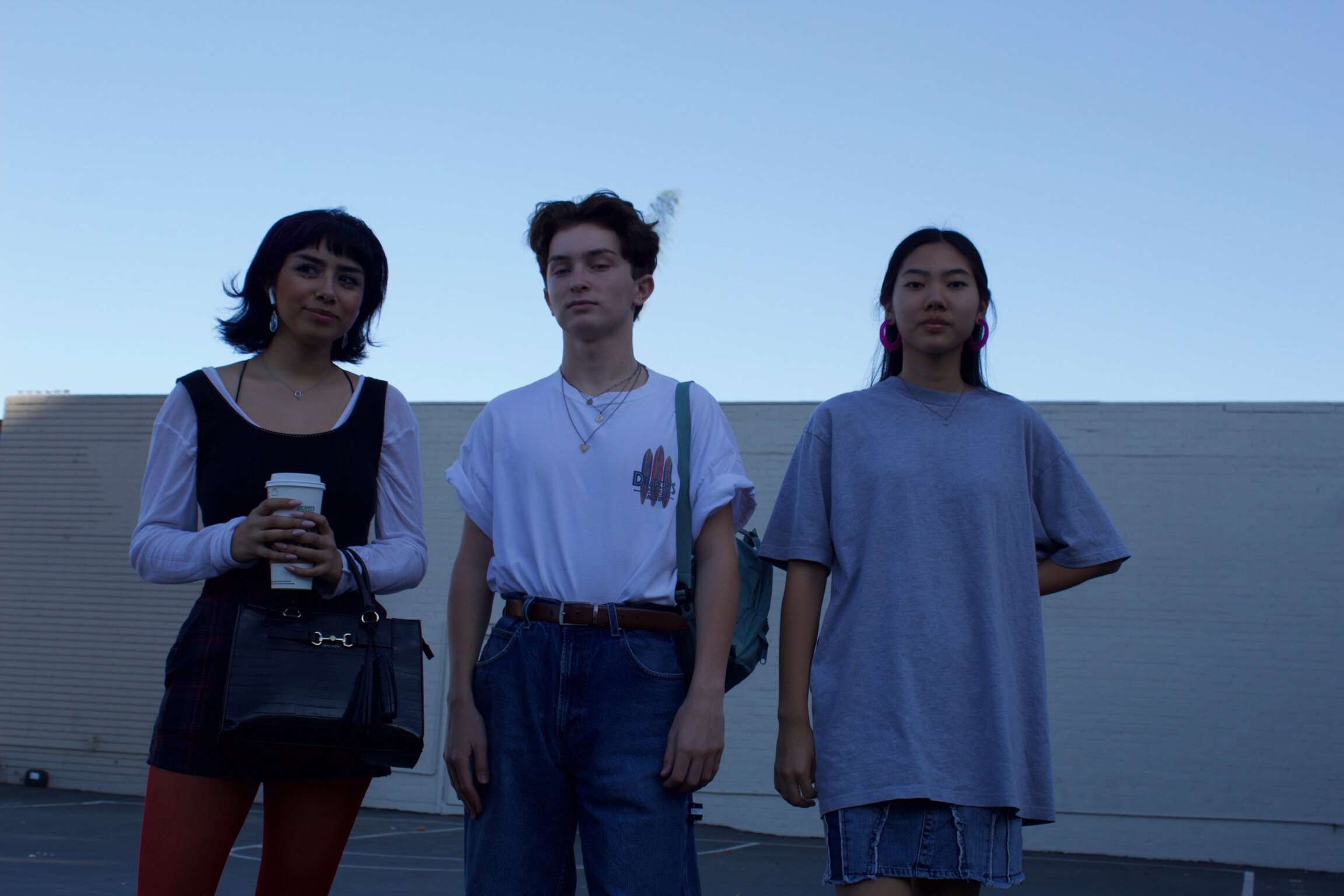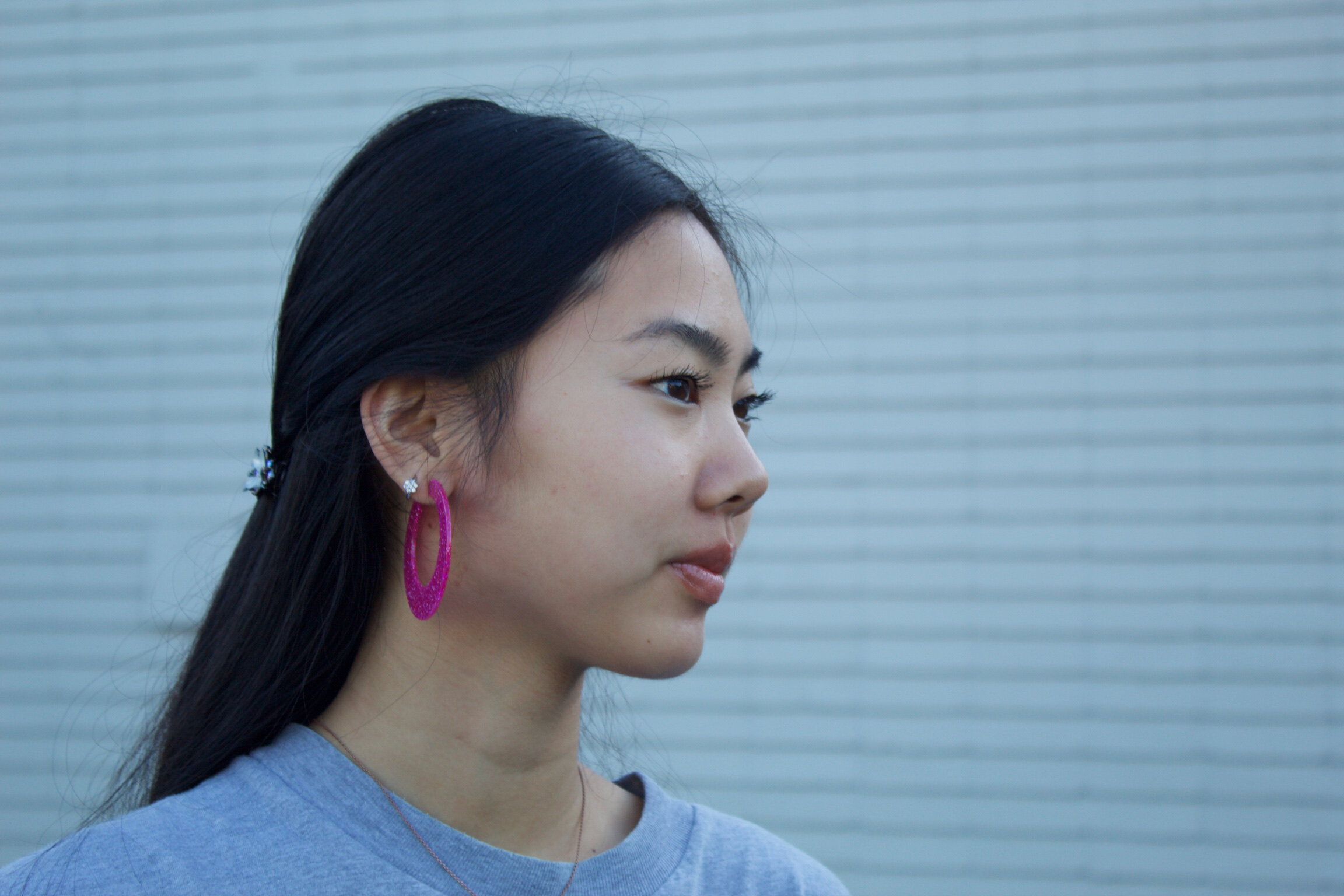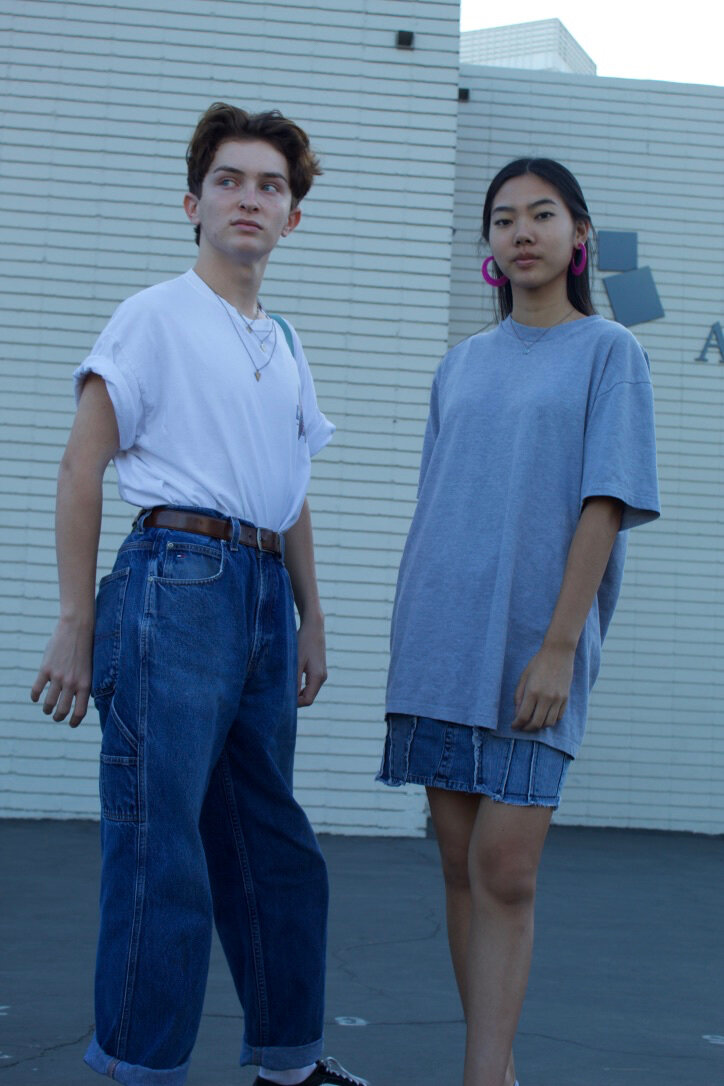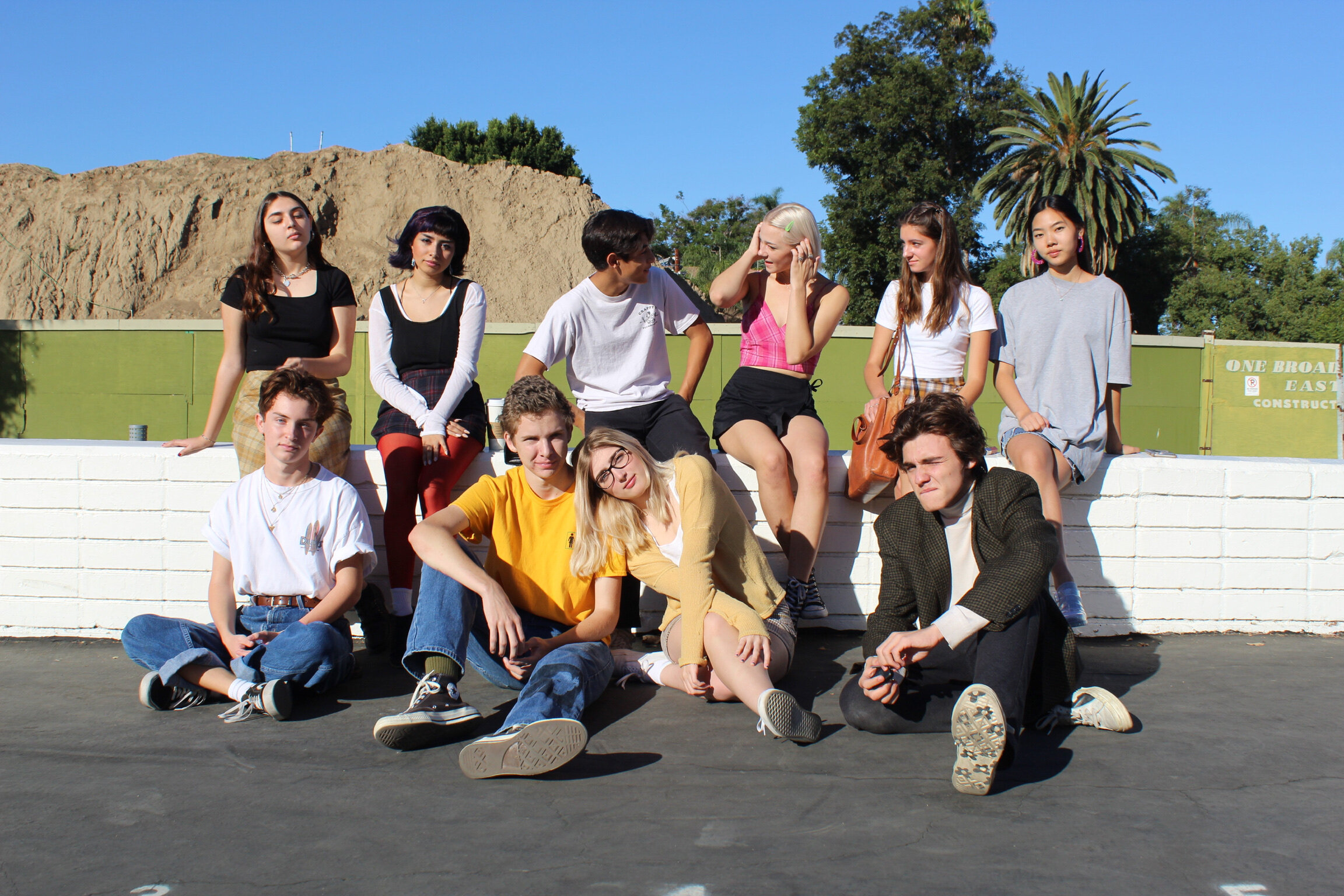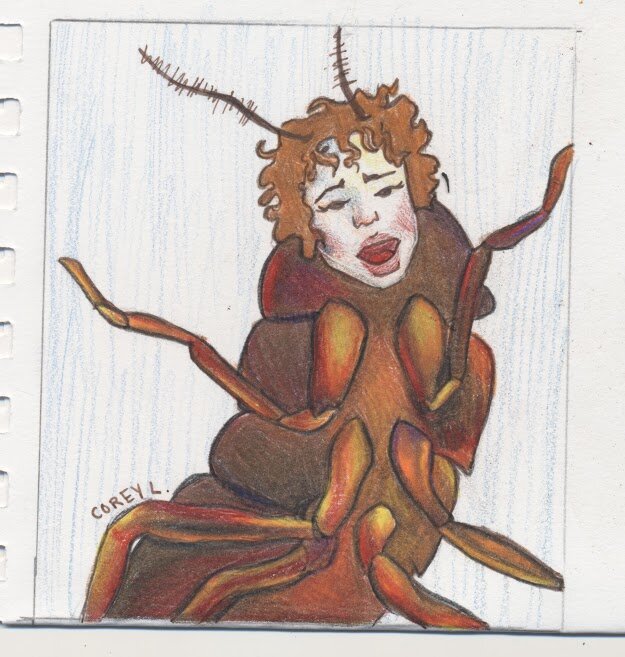
Table of Contents
Mythbusted: New Lottery System
Frankie Fanelli - Executive Editor & Louis Tonkovich - Satire Editor
Noise and Art; Where Do We Draw The Line?
Anica Sherry - Staff Writer & Sydney Coleman - Staff Writer
Santa Ana, Before OCSA
Jennifer Woo - Staff Writer
The Wonders of Daiso
Viviana Velasco - Staff Writer & Illustrator
Ask Napkin
The Search for a New Conductor
Anica Sherry - Staff Writer
The Middle School Dance Saga
Louis Tonkovich - Satire Editor
Strike to Save the World
Monica Johnson - Staff Writer
Fashion: High School Cliques
Anya Ernst - Co-Editor-in-Chief & Frankie Fanelli - Executive Editor
This Was Halloween: Halloween Highlights
Season of the Roach
Corey LoDuca - Staff Writer
Comic
Viviana Velasco - Staff Writer & Illustrator
A Modest Grow-posal
Kyle Keller - Multimedia Co-Editor & Evolution Radio Host
What If We Voted? Just Kidding... Unless...?
Frankie Fanelli - Executive Editor
80’s vs. 90’s
Maddy Ernst - Online Co-Editor-in-Chief
“Diaspora Art” & Navigating Generational Trauma
Sydney Coleman - Staff Writer & Evolution Radio Staff
Senioritis
Anya Ernst - Co-Editor-in-Chief
Horoscopes
Maddy Ernst - Online Co-Editor-in-Chief
Mythbusted: New Lottery System
Frankie Fanelli - Executive Editor & Louis Tonkovich - Satire Editor
On September 19th, Ralph Opacic sent a bulletin meant to “clarify some misinformation circulating regarding changes in OCSA’s admissions practices.”
He stated that because OCSA’s charter is up for renewal in June of 2020, the school underwent review to make sure they were up to California Education Code. This prompted OCSA to make some “changes to [their] admissions process.”
He went on to explain that the procedure of filling out an OCSA application, which every student reading this did in order to begin the application process, will remain the same.
However, the letter seemed to say that the process of auditions has been replaced with “placement activities.”
The letter was met with confusion and concern, leaving many to wonder what exactly these placement activities entail, whether the admissions process was being revamped completely, or if they were simply renaming the procedure they’ve always used in order to get it past the new American Civil Liberties Union (ACLU) guidelines?
OCSA and other charter schools across California have come under scrutiny from the ACLU for their challenging application requirements that limit who can attend.
Some 253 charter schools all over Southern California were found to have some combination of these requirements in place, including OCSA.
The California Charter Schools Act calls for every charter school to admit all students who wish to attend. Under the act, admissions processes like auditions are illegal, as they limit the students who can ultimately enroll at OCSA.
Because charter schools receive public funding, according to the California Charter Schools Act, their admissions policies must be equally as public. Certain admissions requirements, some of which OCSA has used, discourage English learners and undocumented students from applying. These admissions requirements make it easier to exclude those who don’t meet certain English proficiency levels, don’t meet a minimum academic performance, or whose parents aren’t in a place to volunteer or pay money to a school.
A major concern cited in the ACLU and Public Advocates study is that Charter Schools have failed to reach out locally, and that the demographics of the schools don’t represent the demographics of the nearby communities. This results in a charter school system that appeals to privileged students instead of students from disadvantaged backgrounds.
Looking at the OCSA student body, for example, only 23% of students at OCSA are Hispanic, in contrast to the 93% of the Santa Ana population. Accessibility is recognized in the study to be largely drawn along racial and income based lines.
Along with the inclusion of a lottery style admissions process, OCSA’s admissions code stresses the importance of the student body accurately reflecting the population of the district. Up to this point, this has not been the case.
Legally, charter schools have the same admissions requirements as public schools, and must be accessible to any and all students, regardless of artistic or academic merit.
In the ACLU Report “Unequal Access: How Some California Charter Schools Illegally Restrict Enrollment,” the ACLU uses testimony from a grandparent of a former OCSA student.
This student, who had frequent health struggles, was asked to leave OCSA when his GPA fell to a 2.0. In the 10 days he was given to improve his grades, he succeeded in raising his GPA, but was still dismissed from the school.
In the OCSA Charter, it states that all students must have “a minimum academic GPA of 2.0 or better,” to attend the school.
Change in admissions policy could hopefully address all these issues, because an open acceptance policy would open up the school to less privileged students with more diverse backgrounds.
The OCSA Charter, which is from 2015, also states that, “Should there be more “Qualified” students than enrollment slots allow...a public random drawing will be held to determine student enrollment.”
So the lottery system mentioned by Opacic in his September letter was already a policy measure back in 2015.
Now, in 2019, one year before OCSA’S Charter expires, this four-year-old measure will actually take effect.
What was interpreted by the OCSA community as new, drastic changes, is mostly just OCSA retroactively enforcing school policy that already exists. OCSA is making some last minute efforts to adhere to its own set guidelines when under pressure from the ACLU and at a time when their charter is almost up.
OCSA was named in the top 3 public high schools in Orange County by the OC Register, an accolade it advertises. But it can’t truly claim this title when the institution serves mostly the white, middle class of Orange County.

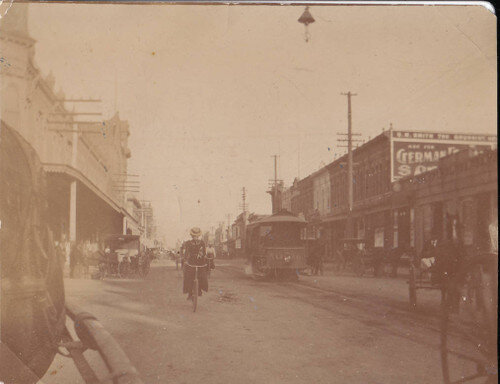
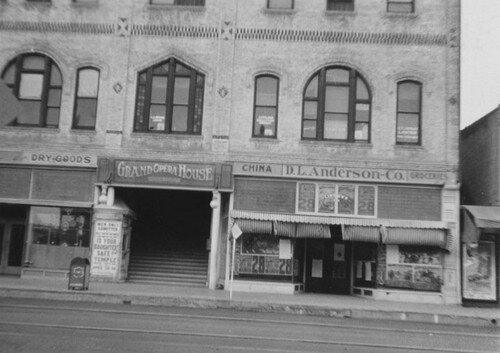



Santa Ana, Before OCSA
Jennifer Woo - Staff Writer
At first glance, OCSA looks like anything but a school. Without the OCSA logo plastered on every building, our campus looks like a mishmash of office buildings, warehouses and a church, which is exactly what Santa Ana was before OCSA.
The Tower, OCSA’s landmark building, was a seven-story United California Bank (UCB). Circa 1960, Santa Ana’s UCB was nearly identical to the Tower in 2019, besides UCB still being painted white, and having a UCB logo instead of an OCSA logo.
The Annex was home to both Chandler’s Furniture Store, and Libreria Martinez Books and Art Gallery. Librería Martínez Books was a well-known landmark for many Hispanic locals and owner Rueben Martínez was dedicated to preserving Latino culture through literature.
Martínez was a successful barber who decided to start selling books in Spanish for the community. When one of his other community bookstores closed to create an education center, he was sad, but grateful that his space would still contribute to community education. It is an honor to be able to be educated in the arts on land that was once dedicated to preservation of arts and culture.
Symphony Hall used to be a church of Christian Science that many upper class families from Floral Park attended. In 1960’s Santa Ana cityscape, the church’s ornate designs and beautiful arches contrasted against the UCB’s linear architecture. It stood on its own, and was not overshadowed by the multimillion dollar DMS building. In a photograph of the church, you can see the steps where students now gather on Fridays to dance, the tree where many juniors now eat lunch, and the walls of stain glass windows that now watch over OCSA productions.
Symphony Hall’s basement, which currently houses Josh Wood’s office and Creative Writing library, was once a child care and the band room was a Sunday school.
The Webb Theatre was a former Bank of America that was established in the 1960’s. According to Suraya and Joseph Iller, former employees of the bank and OCSA parents, the Event Center housed the customer service representatives who answered incoming calls, and the main floor had the bank tellers. The basement had the check order department and the bank vault.
In 2005, the Bank of America later became the OC Pavilion Performing Arts Theatre. According to the OC Register, the OC Pavilion was mostly a venue for tribute band concerts, and the musical theatre company, 3D Theatricals.
The Webb’s event center was formerly a classy restaurant, Ambrosia, owned by Santa Ana developer, Mike Harrah. Ambrosia was not very successful, due to its strange location above a theater, but it gave OCSA culinary students access to professional kitchens when the theater/restaurant was sold to OCSA in 2010.
Ralph Opacic had originally hoped to build a new theater for the school, but when the real estate market crashed in 2008, he turned to the OC Pavilion as an opportunity to expand the capacity of OCSA’s productions.
The lot where the DMS currently stands was Marinello’s hair salon, according to OCSA Registrar Laura Ely, and later became a Jewish community center. It then became a parking lot for OCSA before the DMS was built in 2015.
The Visual Arts Center was formerly an architectural firm, possibly McGrane Design although that is not definite.
There has been a dramatic shift in Santa Ana’s environment throughout the years. According to Mr. and Mrs. Iller, downtown Santa Ana has changed “from family owned businesses to now mainly art galleries and alternative food restaurants”.
4th Street has a unique cultural history in Santa Ana. The beloved 4th Street Market was originally the Grand Opera House, an iconic Santa Ana landmark built in 1890. According to the LA Times, it housed “plays, vaudeville acts, amateur boxing matches and yearly high school graduation ceremonies” before it closed around 1923. This area of downtown Santa Ana had many parades, cultural events, and gatherings.
From a community of small family businesses to an artisan downtown, our neighborhood has undergone a dramatic transformation throughout the years. This article has only scraped the surface of the history of our buildings and the ones we pass everyday. We go to school on the same ground that has been home to so many different establishments and we walk through centuries of history everyday.
Noise and Art; Where Do We Draw The Line?
Anica Sherry - Staff Writer & Sydney Coleman - Staff Writer
As attendees of an art school, music is not unfamiliar to us. Whether or not you plan on devoting your life to music or you simply enjoy listening to a couple jams to accompany you on your way to class, music is present every day in our lives
Think about the music we hear that is unintentional and goes unnoticed every day. Car horns, birds singing, the chatter of students in a crowded breezeway. Where do we draw the line between music and sound?
In a historical context, music has existed since the beginning of civilization. It was functional. People used it for ritualistic purposes, to speak to a higher power, warn others of danger, call a gathering, communicate. Most civilizations developed a way of notating music as well. Aural music tradition has been supplemented by written notation in many cultures.
Let’s take ourselves back to the years of the Renaissance, or even Baroque musical eras. Music had been notated in churches using the five lines of the staff (inspired by what music teachers had easy access to: five fingers). The use of “Ritornello form” and “Sonata form” by early Baroque composers brought classical pieces structure, or an outline, with repeating sections and themes. European classical pieces that follow forms like this are comparable to songs with a verse, chorus, verse, bridge. Are these qualities integral to what we consider music?
Of course, that perception of music is extremely Eurocentric-- it accounts only for “a small part of the global scale of music” says Lawson Madlener, PM Film and Game Scoring teacher. African drum circles are infused with intricate rhythms. When Europe scrambled for Africa, white people who stumbled across African music were quick to call it unorganized and chaotic, simply because it wasn’t in the standard 4/4 tempo. To play the zither, Chinese musicians developed an efficient way of notation music on tablatures. Classical Indian music and music of the Middle East is so specific to the point that there are musical scales dedicated to certain deities, or to the time of day. In every culture there is a preconceived notion of what music is and it’s largely influenced by our personal experiences and backgrounds.
When it comes to contemporary music, there is much that could be discussed. One could easily watch a performance of John Cage’s 4’33” and claim “That’s not art!” But it’s debatable whether or not it’s up to the creator or the audience to decide if it is. Adam Neeley’s Exigence was created as a “vendetta against the cult of the written score” and to some it may sound like a blob of techno noise, but it does have a score and it does feature performers playing with intention. That brings up the age-old question of whether or not sounds from nature are art. It’s easy to say birds chirping and wind rustling through leaves is “music to your ears” but does sound need to have intent to be labeled as music?
Music is often defined as “organized sound.” The Merriam-Webster Dictionary defines music as “vocal, instrumental, or mechanical sounds having rhythm, melody, or harmony.” The Oxford dictionary goes even further to list “beauty of form” as a qualifying factor. But who decided that this is what music is and must be?
It is important, as with the dictionary definitions of any abstract concept or practice, to analyze the contexts in which the definition of music arose. English dictionaries are written by an elite, Western class. The existence of a white, elite body to ascribe official definitions to abstract concepts is inherently flawed, as it places restrictive parameters on immaterial concepts, which constitute a deeply Eurocentric and white-washed worldview. (This is also applicable to the dictionary definition of “racism”. The concept of racism as defined by white people was intentionally structured to negate the fact that racism is systematic and, as beneficiaries of this system, they cannot fall victim to it.)
It’s no secret that there is much gatekeeping in regards to musical expression. Often times, people’s artistic expression is dismissed to their lack of experience with archaic ideas and “fundamentals” of music. Until musical employment was broadly applied as a symbol of status and merit by Europeans in the Baroque Period, musical expression did not require access to resources beyond the will to create something and the means to do so. Peer-to-peer music education has existed for as long as the music has. From picking up folk songs with your grandparents to belting at church on Sundays, informal music education is paramount for maintaining a general appreciation of music, but through the establishment of conservatories, “quality” music education is deemed a privilege only appropriate for the upper class.
Music began as a form of aural tradition; a means of resistance and survival unrestricted by the boundaries of contemporary Western art and expression. Nearly all genres of music that have been popularized and commercialized originated as a language of resistance; a coping mechanism to ease the extreme weight of structural and generational trauma and violence. As stated by Gregory Fletcher, professional musician and teacher in the Popular Music and Jazz conservatories, “Black American music was never rooted in entertainment; it was always for a sense of freedom.” Here, especially, the discriminatory and supremacist undertones of giving a definition to “music” are clear. The need for a definition of an abstract and, for many, liberating practice is not only unnecessary, but it allows for the policing of artists of color’s expression.
Who is to define what music is and is not?
When it comes to music, “we feel that, in order to understand [it], we have to be able to define it” (Fletcher). But perhaps music should not exist within the confines of a comprehensible definition, however it may ease the mind to have one. Music transcends all boundaries. It exists as a universal and unifying language. It is an abstract and intangible concept whose meaning is different to everyone.
The Wonders of Daiso
Viviana Velasco - Staff Writer & Illustrator
Daiso. Die-so. We’d die without it. This little magical place is all you could ever ask for. It’s name is spread throughout the halls and classes of OCSA. Many students spend their time walking down the clean and pristine aisles, looking for new stationary or neck pillows for class. The possibilities here are endless with new findings each day.
Once you walk right in you’re already met with adorable nick nacks and small costume accessories for Halloween that’s right around the corner. Daiso isn’t your regular Dollar Tree nor your occasional 99¢ Store; it is so much more. It’s unique layout and merchandise have a way of sticking out in their 12 locations within Orange County. The quality of their products have a way of putting other dollar stores to shame. After opening their first store in the United States in 2005, the store blew into a large craze with its great quality and affordability. Since then, 78 stores have opened across Washington, California and Texas however that doesn’t seem to stop them from expanding. According to their website, Daiso has about 2,800 stores in Japan alone and over “4,000 stores worldwide”. With their “kawaii” designs in demand, especially with Gen X and Millennials, Daiso won’t be stopping any time soon.
Their items carry Asian lifestyles that keeps any person’s daily life simple and resourceful without lacking any originality. From pop-up floral lanterns to hand towels with pandas rolling around, Daiso has everything you can ask for. Need any cooking supplies? Daiso’s got you with it’s assortment of stainless steel pots and pans. Want to spend money on dining sets you know you won’t use? This store’s ready to help with providing a variety of cute cups and bowls that you can easily keep in your cupboards for a very long time to show your unique tastes. I for one, was already ready to get my college dorm shopping going after spending 4 minutes in the Daiso that wasn’t too far from my house.
Daiso constantly draws Asian shoppers, as well as anyone else who loves Asian food or culture to its store. Their whimsical products catching a lot of attention from Youtubers who post many videos of them showing off their Daiso hauls. After spending 20 minutes wandering the aisles, I finally left the store with a Calpico soft drink in my hand and a baked wheat cake in the other. I had to stop myself from buying too many stickers and sticky notes, among many other things that I found so adorable.
Daiso also remains popular on school grounds. In an art school, the need for practical art supplies is a must. Many of the students at OCSA appreciate the simplicity of Daiso’s merchandise many of them being in Visual Art or Digital Media. “It’s pretty good quality with simple aesthetics,” said Quynh Anh (VA 21), “stuff like notebooks, palettes for art, pens, brushes, washi tape etc etc.” Even those who aren’t in the art field still find use for Daiso’s products that are aside from conservatory work. From cat index sticky notes to fine gel pens, the students of OCSA use these to help them keep their academic life organized.
Anyone can go to Daiso. All those who find collectiveness in Shiba Inu sketchbooks and rabbit rice molds will find their needs in this quaint store. Daiso still continues to attract many shoppers with their rarity in their brand, making this one heck of an allowance spender. Quynh Anh couldn't have said it perfectly, “If I could I’d live @ daiso bro.”
Ask Napkin
My friend Napkin,
I recently was in the bush parking lot when I saw Drake Arthur open his trunk and there was bananas filled to the brim. I was confused and wanted to confront him for holding my brothers hostage but didn’t know how. What should I do?
Banana Boy
Dear Banana Boy,
Frankly, I am not quite sure where to begin. What I take a way most from this cry for help was the hostage situation. Are your brothers okay? Do we need to call the police?
But now to get to the real issue, the bananas. As long as you are not severely allergic to the blessed fruit, this sounds like a positive situation to me. Take this time to share some bananas with your pal! Make a banana split or add them too a smoothie to get some good use out of them. All I ask is that you don’t judge Drake’s decision to fill his car with bananas. There comes a time in all of our lives our car will be packed with produce, so it’s wise to respect him at this time and let him deal with his fruit in peace.
Sincerely,
Napkin
Hello Napkin.
I would like your advice, as I am very distressed. I think the 7th graders here are too big. My ego is very hurt every time one of those giants stomp past me in the hallway. As I’m sure you can imagine, I feel very inferior. How do I make my arms bigger?
Thanks. I need an answer ASAP as it is very urgent. They grow exponentially every day.
Sincerely,
Prideful (not small) Senior
Dear Prideful BIG Senior,
I can completely sympathize with your predicament. It seems that every year the seventh graders look the size of second graders, expect this year we were met with some 12 year olds who are 6 foot and up! My advice: wear some high heels and flaunt your superior upperclassman status. And for all you middle schoolers, drink some coffee (I’m begging you)!
With love,
Napkin

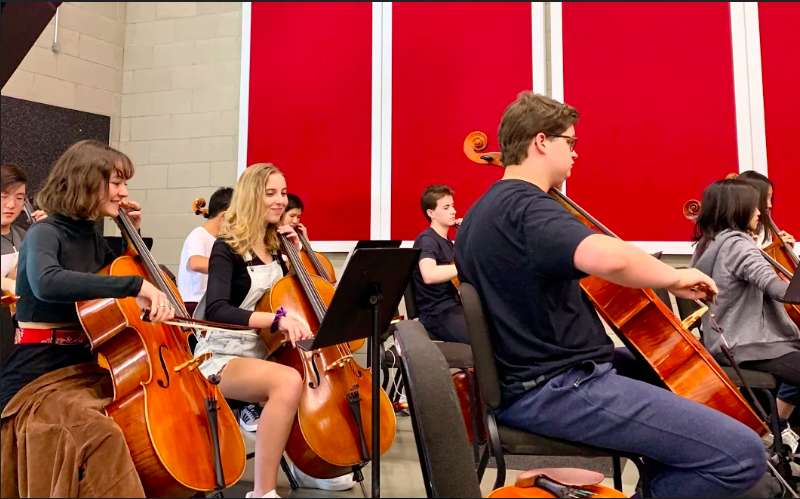
The Search for a New Conductor
Anica Sherry - Staff Writer
Following the departure of Instrumental Music’s beloved, long-standing symphony conductor, Christopher Russell, was a nationwide search for qualified candidates. For many, the search’s procedure was new and a bit uncomfortable. Others believe it’s beneficial to the conservatory.
Instrumental Music has encountered many changes within the conservatory in the past few years. The addition of the DMS to OCSA’s campus 4 years ago greatly expanded IM’s potential and dramatically increased the number of musicians accepted into the conservatory as freshmen, now either graduated or a mere two years from graduating. The list of classes offered to students, which once included music therapy and film score, have been limited. Changes in the staff members of IM is one of the more recent alterations. Dr. Nicholaus Yee, second year Strings and Orchestra coordinator and Dr. John Reynolds, director of the Jazz Department make up IM’s newest faculty.
The issue some students and staff have mixed feelings about are the steps being taken to conclude the last round of the conductor search. The search began after Russell announced his departure in the spring of 2019. This year, Symphony Orchestra is going to have at least three shows, per usual, but for each concert, one of the three finalists in the search (one of them being Dr. Yee) will be guest conducting. This serves as a “test run” for each conductor, very similar to an audition.
Each finalist (with the exception of Dr. Yee, as he is the current stand-in) will be given a couple rehearsals to familiarize themselves with the orchestra. Ansh Vashisth (IMS ‘21) says he “feel[s] bad for the seniors because it’s their last year and they’re kind of like the guinea pigs for next year’s orchestra.” Another student in IMS who wishes to remain anonymous said, “It’s a quarter of our high school education that’s being used to make someone’s job easier...and if it’s [the students] being used like that, then we should have more of a say [in choosing the conductor] than anyone else.”
And yet, many students oppose this perspective. Sarah Elliot (IMS ‘21) believes the students getting a feel for each conductor will be more advantageous than not. The decision to approach the search in this way was not up to Yee, but rather Maria Lazarova and Teren Shaffer, who will in turn be the ones choosing the winning conductor. Yee says “That’s just the way the administration wants to do it.” In fact, this is a very professional method of conductor searching, which is used in many undergrad programs and professional orchestras. In that sense, this will prepare those who wish to pursue music for the “real world” and adapting to sudden changes in an orchestra.
Recently, it seems that the level of competition in the orchestra, while still being ambitious, has decreased. An overwhelming number of the upperclassmen in symphony are less invested in the previously high stakes orchestra placement and seating arrangements. Vashisth suggests this might be a consequence of the patchy communication between the staff and students. Before the first concert of the year, there was a group of students who were under the impression that the optional seating auditions would only affect the first three chairs of the section. This impacted the number who participated and led to a minor debacle, but fortunately it was resolved quickly.
“Last year there were people competing to be concertmaster and now it’s like nobody wants to do it,” says Cole Daniel (IMS ‘21). Building blocks that motivate student musicians to perfect their sound have been taken away. The lack of juries (playing tests) and the pieces being rehearsed are not as demanding as selections in previous years. This is not necessarily a bad thing, it just gives students the impression that they don’t need to practice.
In general, the students of IMS are content with their music and each other. Collin Byun (IMS ‘20) says “There’s always been a positive ambience, it’s been overwhelmingly supportive.” For symphony orchestra this is an era of transition and potential. We have yet to see what the future of IMS holds, but we’re excited.
The Middle School Dance Saga
Louis Tonkovich - Satire Editor
My associate and I felt out of place.
Tickets were 10 big greens, but we were with OCSA Evolution and here to find a story. We got our tickets, skipped the line and were shown into the hottest social destination in town: the Middle School Dance.
With 10 dollars burning a hole in our pockets, and our hopes held high, we stashed our bags in a secluded corridor, prepared ourselves and entered the dance. I couldn’t help but think I was stepping out of my territory, and into uncharted, long-forgotten waters.
Within seconds we had accrued suspicion from at least five leadership students, well groomed administrators in training who spent the rest of the afternoon half-heartedly eyeing us to make sure we weren’t being too seditious.
It was hard for anybody who wasn't a middle schooler to get invested in the event. All the teachers I remembered from middle school were stationed at various points across the room, looking happily vacant. Something told me they didn’t expect any serious trouble to arise. I had it confirmed by a leadership insider that most OCSA teachers considered the Middle School Dance a very desirable event to chaperone.
Most of the room appeared to be filled with small, well-dressed men hitting each other with balloons. Several were crawling around on the floor, and I made a note to watch carefully where I stepped for the rest of the afternoon. We stood out like sore thumbs. Seniors at a middle school dance. Who ever heard of such a thing?
As it turned out, the balloon was the perfect weapon to battle out old feuds, settle grievances, and exact vengeance. The few boys who weren’t occupied with balloon hoarding/fighting were shuffling around like vagrants, unsure of what to do. The balloons that inevitably popped merited screams from the dance goers.
Later on, not quite screams, but something like them emerged from the dance floor when “Old Town Road” began to play. The voices of the pre-teen masses rose into one prepubescent choir, and unconsciously harmonized in a crescendo so high and piercing that it made any conversation between my companion and I impossible.
After taking advantage of the free pizza, we retreated to the far end of the room, where we could get a better view of the whole scene. We slumped against the wall and slid down to the floor, feeling detached and isolated. I casually mentioned that down here on the floor was the only place we seniors would be on the same level as the considerably shorter middle schoolers.
“What do you mean sinking down to their level?” my companion asked. “We’re on their level.”
As I sat there, my four years of high school seemed to swim before my eyes, and, as I watched, dissolve. We had been inside the dance too long, and we had lost ourselves in the mass group, indistinguishable from and irrelevant to the dark, dancing shapes around us.
Here, the high school hierarchy that had been so painstakingly established in countless movies and TV shows was reversed. Here, we seniors were entirely out of our element — powerless.
My associate busted out a ring pop to tide her over during this most existential phase of our expedition.
I felt almost comatose as the DJ announced that now they would be playing the one obligatory slow song. There was no dancing, the closest anyone got was some semi-romantic swaying.
We made our escape as the raffle winners were announced, and as we walked into the light, I looked back for one last glimpse, and as I did, the entrance gate, well decorated with colorful balloons, tipped over and crashed softly to the floor. Then we were out of the Webb, and once again seniors, once again in control.
Strike to Save the World
Monica Johnson - Staff Writer
On September 20th, millions of people around the world gathered to protest the lack of change regarding climate legislation in light of the United Nations Climate Action Summit.
The youth-led event organized by Greta Thunberg was a great success, and more than 4 million people attended the Global Climate Strike aka the Global Week for Future.
In Irvine, some OCSA students joined in on the strike, including Rose Givens (IA ‘21). She described it as exciting, considering she had never been to any previous strikes or marches.
“There were a lot of younger people and surprisingly older people, a lot of baby boomers which I was really surprised about,” Givens said.
“We were on a corner and a congressman came by and honked, which was cool.” According to participant Valerie Katritch (IA ‘21), the strike provided a plethora of resources and organizations which attendants could sign up for to advocate for climate activism, as well as new information about the strike.
“I actually found out about the Green New Deal.” Katritch said, regarding the plan moving to get passed through Congress. “Right now only 2% of our energy sources are from renewable energy sources but we’re trying to get that to 100% by 2030.”
Anathea Woirhaye (ACT ‘20) attended the strike as well, saying it was “good as part of a broader movement,” but compared it to the recent women's marches in terms of pop activism.
“There were a lot of people who were there to genuinely do some activism, and then there were some people just there taking photos of their kids for Facebook. There was a congressman who drove by and honked, but that was really the extent of involvement,” she said.
Woirhaye described how some climate-related activism has moved to merely finding an idea for a sign online, as opposed to enacting legitimate policies and laws regarding climate change, as well as the importance of activism based on necessity.
In the same way that it is not really countercultural or against social norms to say women deserve rights, a majority of Californians feel positively about saving the planet. So why can’t we make change?
Though protesting and changing your lifestyle to be environmentally friendlier is beneficial, it’s not necessarily the individual human who is predominantly responsible. As much as plastic straws are mentioned as a major source of ocean pollution, they only make up 0.025%, whereas abandoned fishing gear comprises 46%. It is primarily corporations doing serious damage to the environment and its resources. Laws instating practices such as the use of renewable energy in industries could protect the Earth from further harm. After all, it is through more than protests, through the initiation of policy by those in power, where something can actually be done.
Something that seemed to impact many of the strike’s participants were speakers who mentioned intersectionality regarding environmental degradation and climate change. For example, environmental racism and toxic colonialism, which are present in the dumping of trash in economically developing areas and the repercussions they face because of it. Practices like this shed light on how people of color are disproportionately affected by climate change, and how consequently passionate they are about reform in policies.
Woirhaye mentioned a National Geographic statistic that 80% of biodiversity is protected by indigenous peoples, which only make up 5% of the world’s population. Yet, preservation of native land is still disregarded and threatened by industries as well as governments.
Overall, it seemed that the strike aimed to strengthen the overwhelming support for reform in environmental policies, as well as the extensive impact of climate change on social issues and intersectionality. However, the actions after such a display are just as, if not more important in creating real change.
FASHION: High School Cliques
For the November Fashion Spread, we decided to highlight beloved stereotypical high school trends. As much as stereotypes are criticized in today’s fashion scene which is all about individuality, we have them to thank for some of the most iconic cliques featured in all your favorite teen flicks: The Plastics from Mean Girls, The Heathers, The Toros and The Clovers from Bring It On, The Pink Ladies from Grease, and so many more. Drawing inspiration from our favorite teen Rom-Coms and TV series, this month’s fashion spread shines the spotlight on the fun and freedom of high school fashion as a time to express yourself. So we decided to feature some of the most iconic teen fashion stereotypes featuring OCSA students who embody their modern counterparts. The outfits are exaggerated, yet wearable in order to provide inspiration for your own wardrobe.
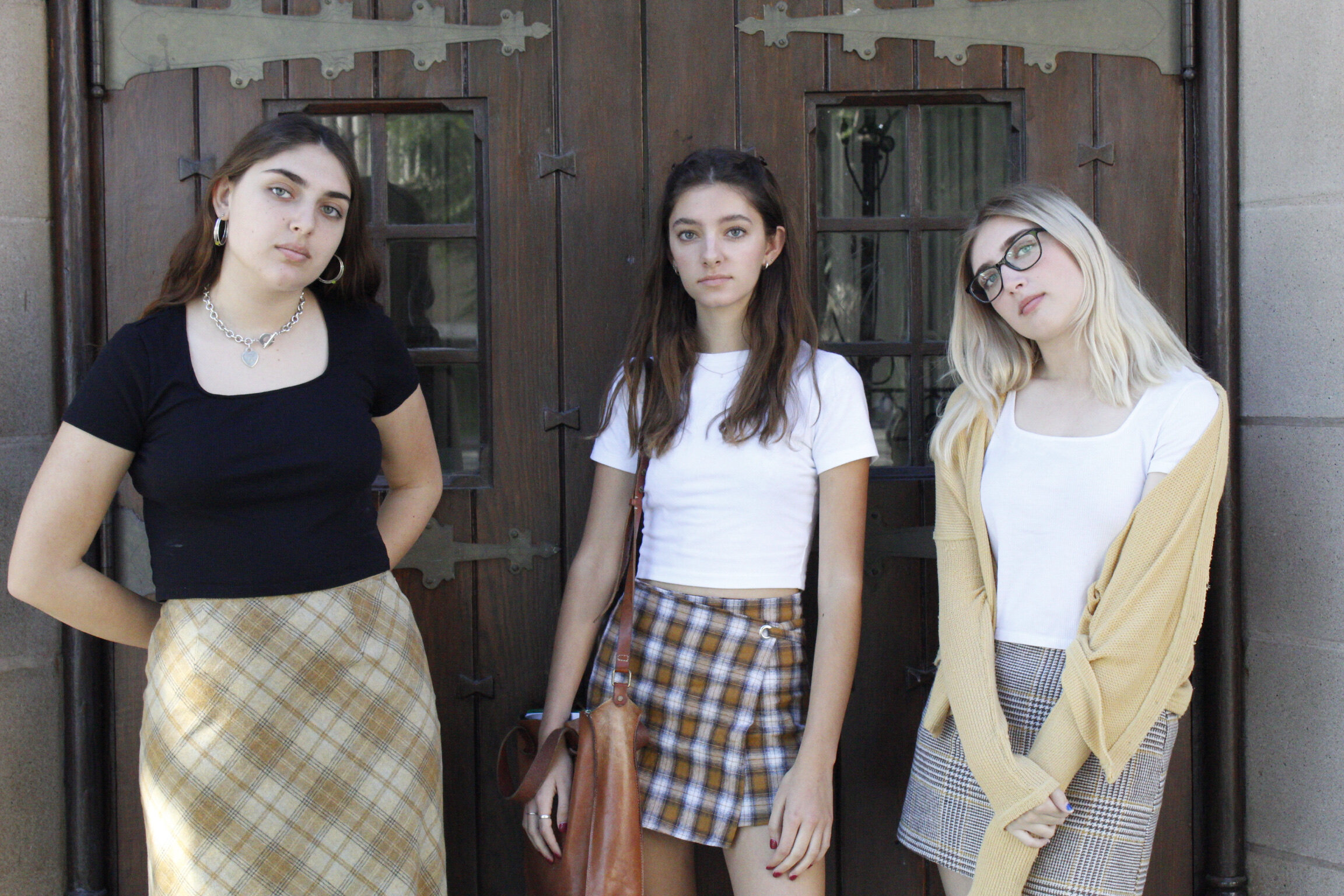
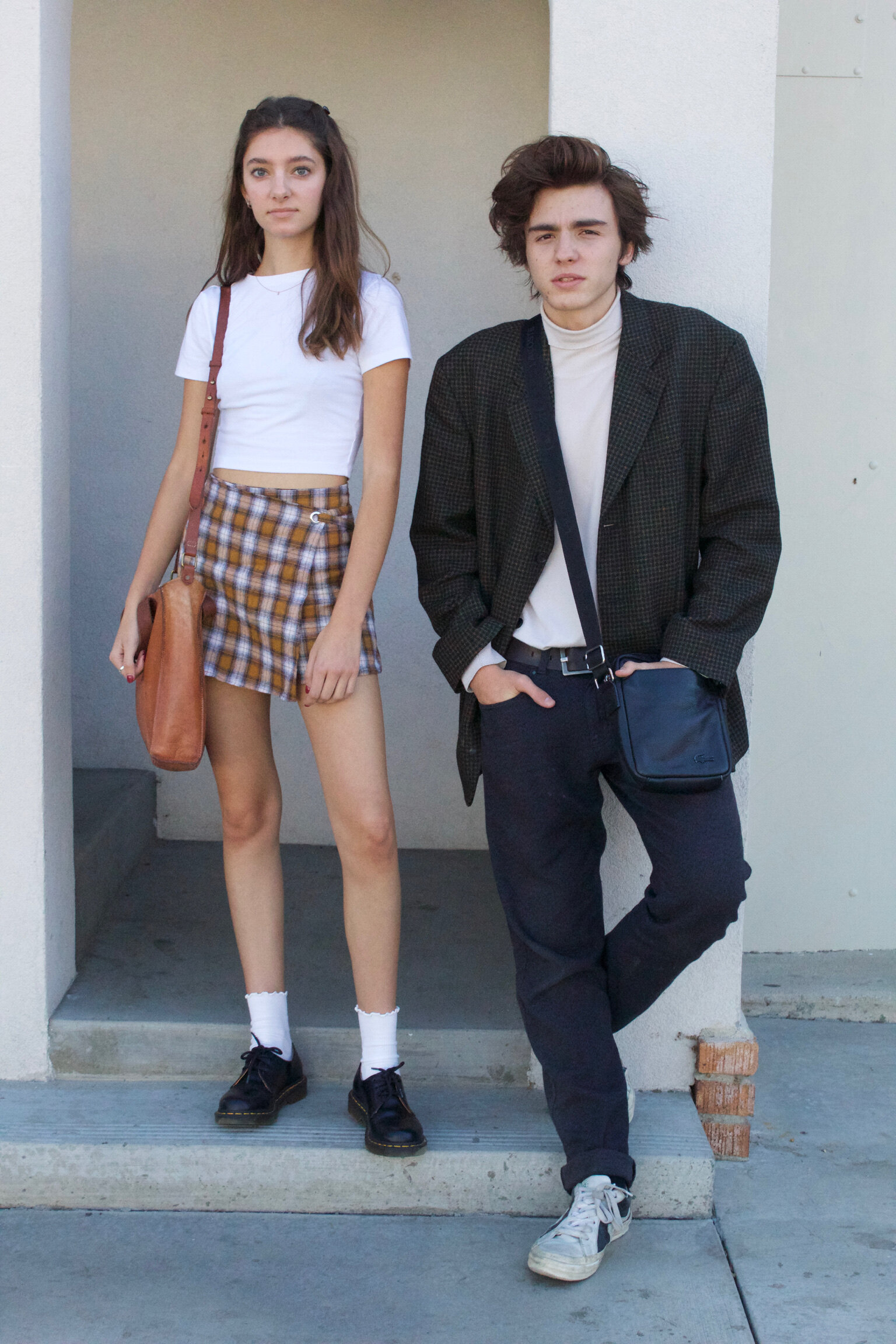


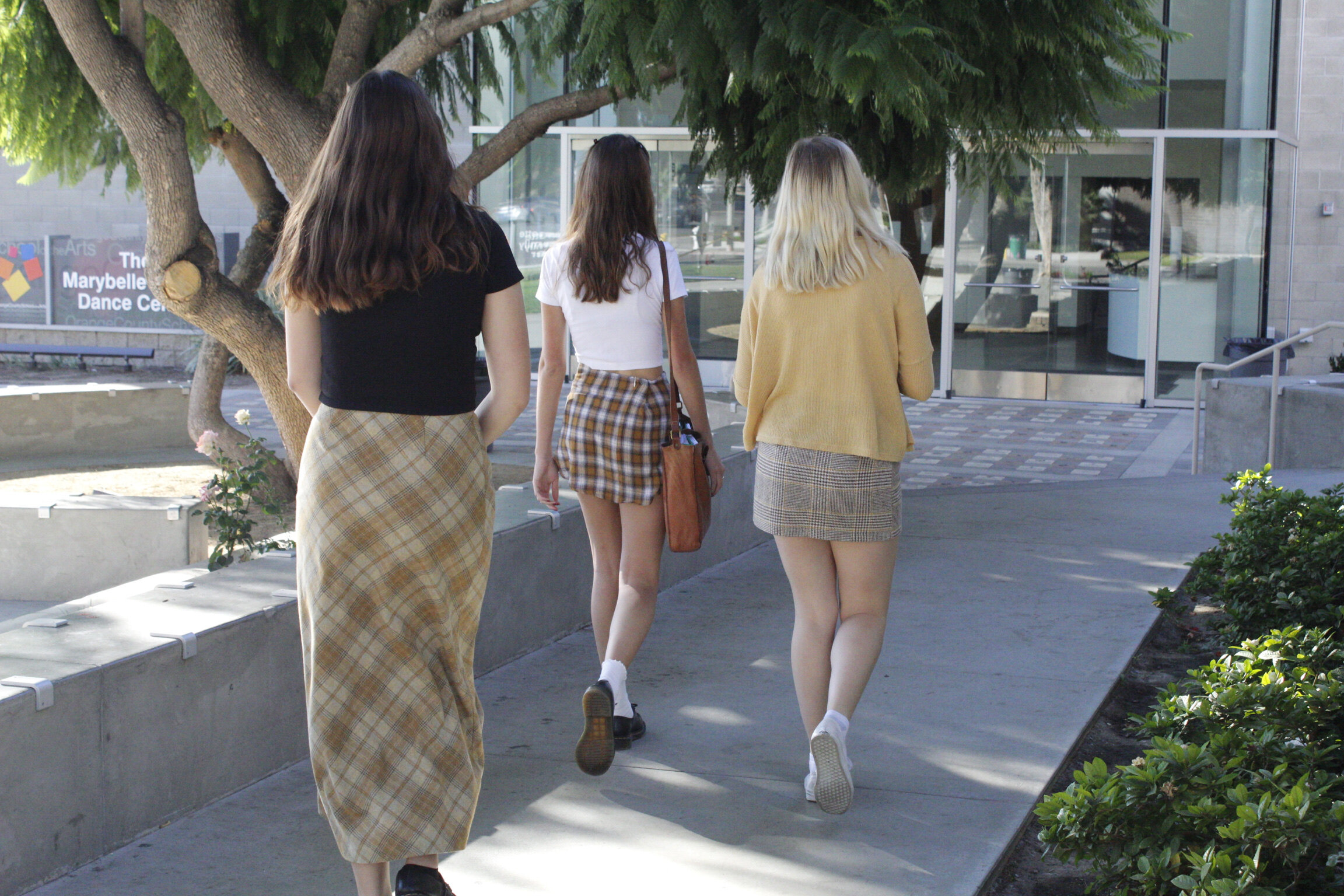
Preppy
Preppy fashion originated in the 20th century from the youth subculture of American universities and college life. It is featured heavily is shows like Gilmore Girls and Gossip Girl, both of which are based largely around upper-class teen students in academic settings. All of our preps are styled in a complementary color scheme of neutral tones like yellows, browns, and whites that are perfect for fall. Plaids, checks, and tweed make up the majority of the patterns and materials featured, as they are both timeless and embody the “ivy league chic” look.
Featured students: Anya Ernst (ACT ‘20), Maddy Ernst (CV ‘20), Alix Page (PM ‘20) and Noah Frech (FTV ‘21)


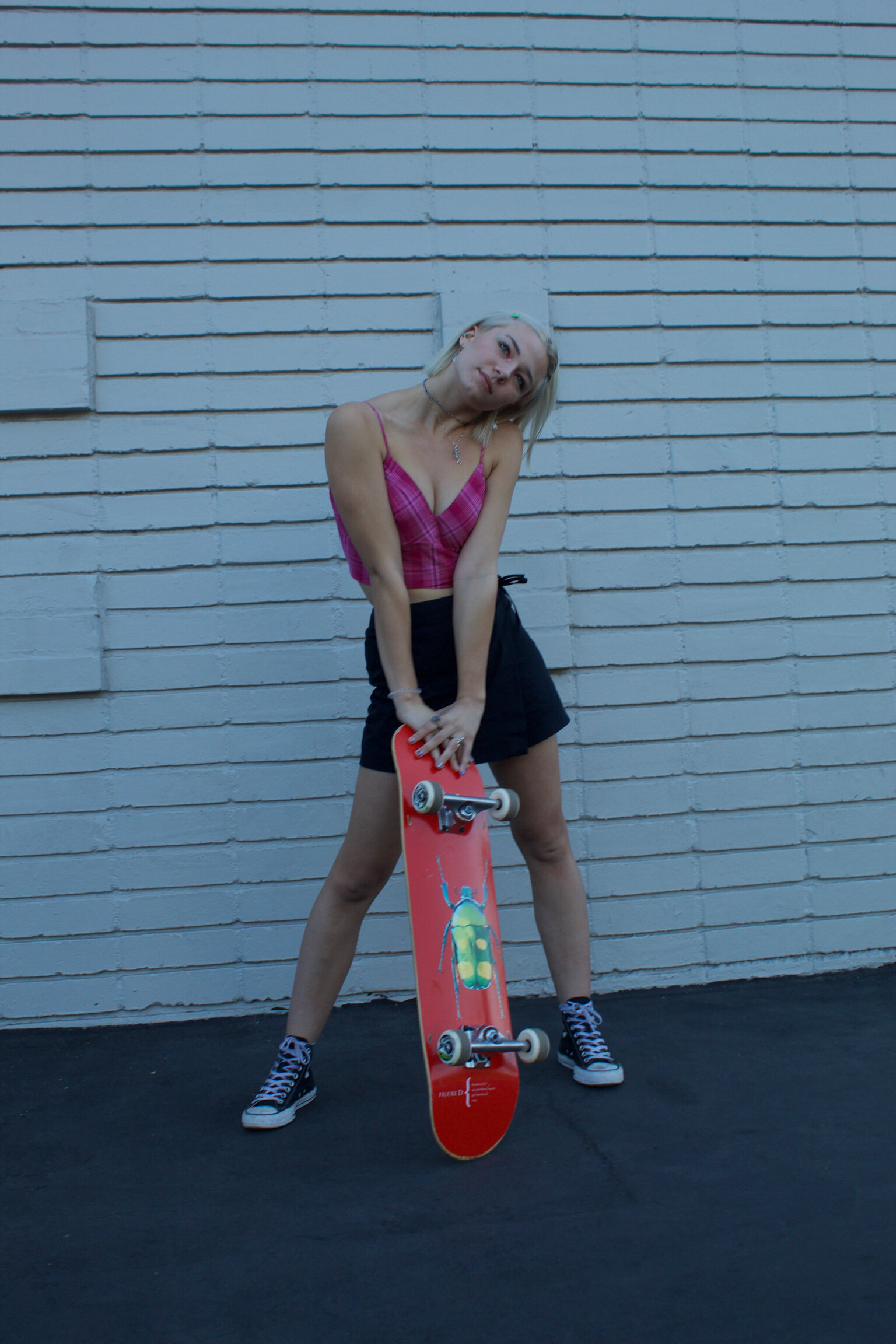
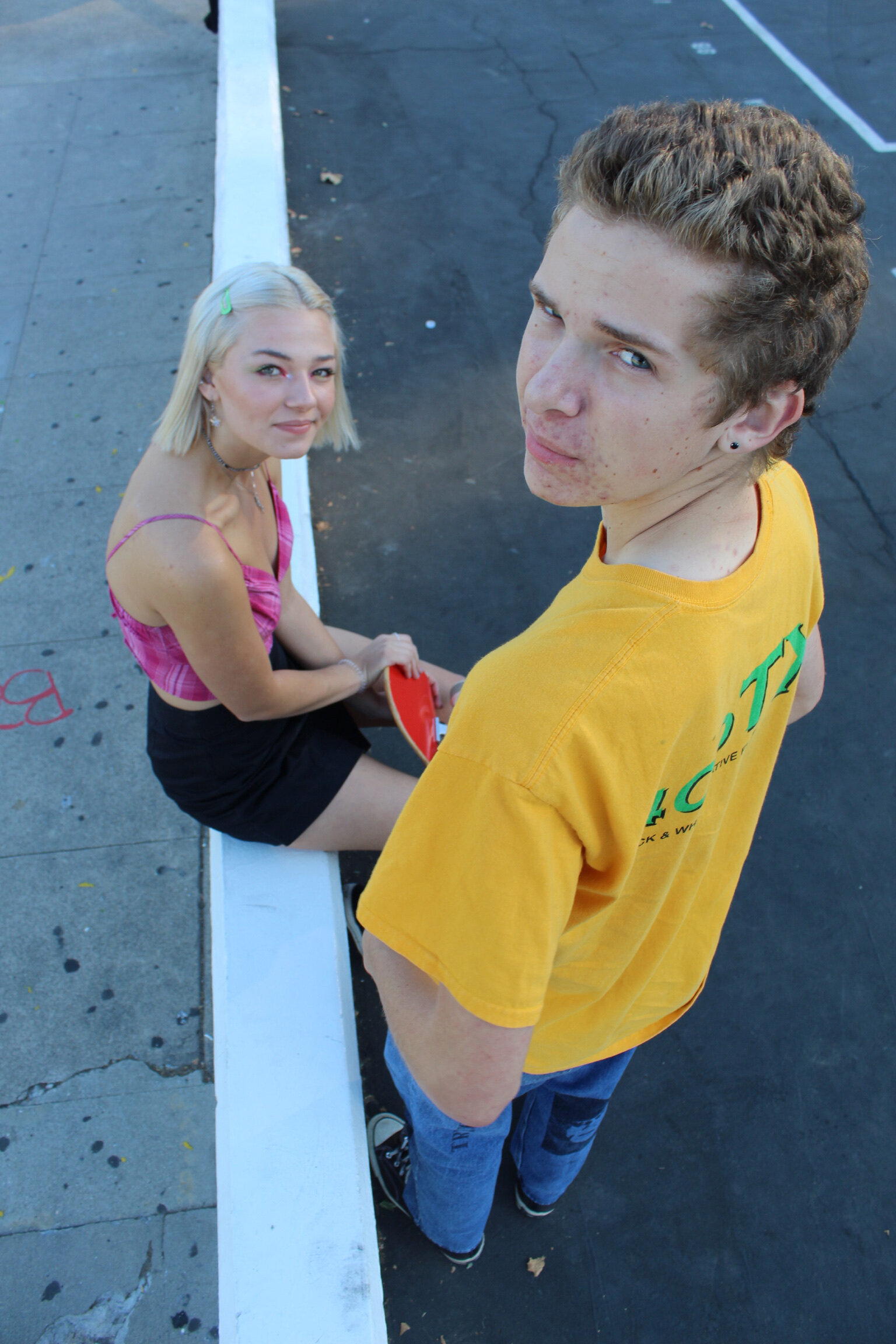

Skaters
Movies like Mid 90’s and Clueless are perfect inspiration to base your skater look around. Brooklyn Price (IA ’21) is pictured in a pink wrap top and a black skort which embodies both fashion and function as it allows her to skate. Stacking rings and necklaces is a trendy way to accessorize while showing off your entire jewelry box. Price does this along with donning the uber iconic ‘90s trend of butterfly hair clips. Calvin Ghaznavi (FTV ’20) and Emerson Trotter (FTV ’21) don oversized t-shirt and jeans which are popular among the skate crowd, as they are both comfortable and practical to accommodate the sport or to just hang out in.
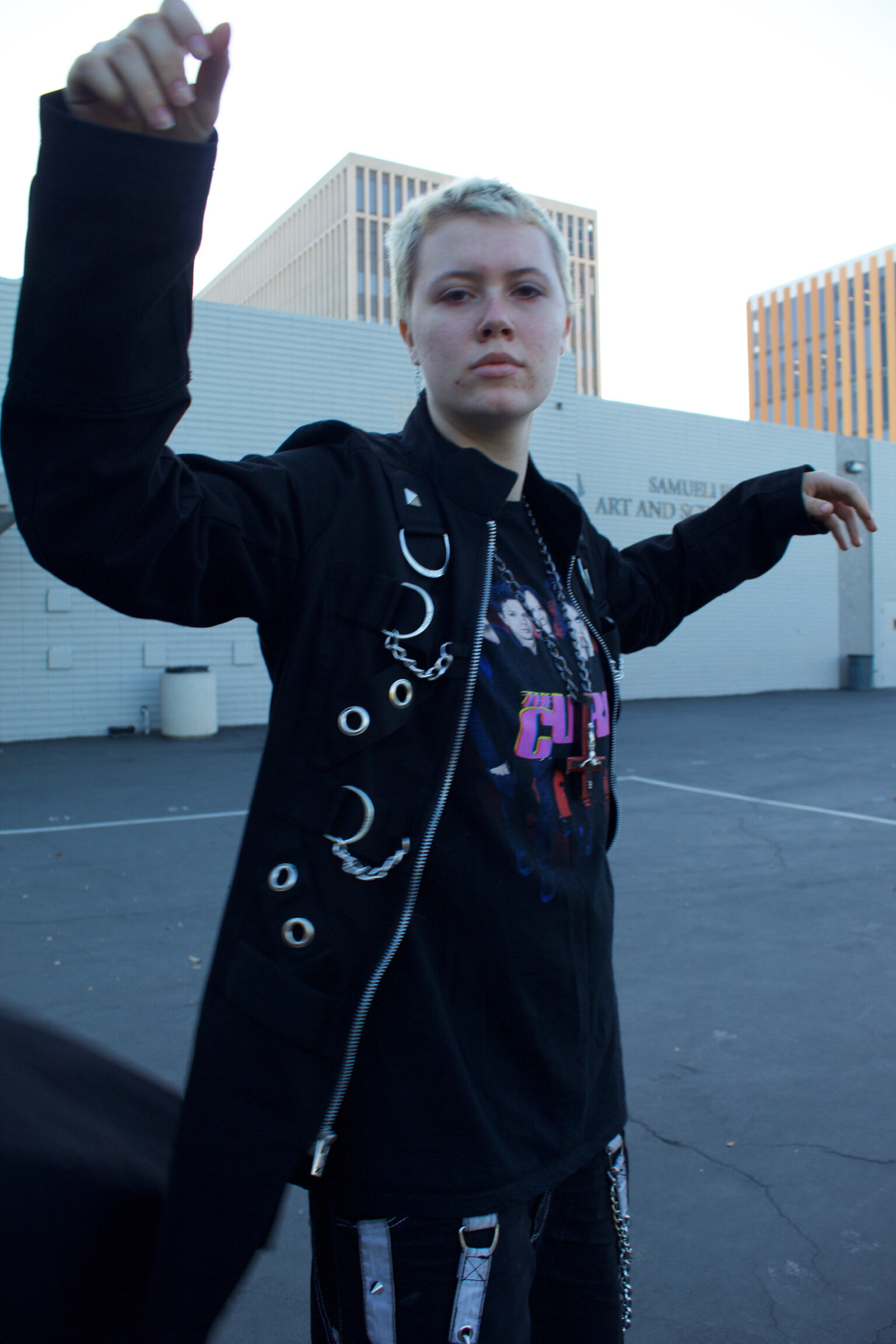

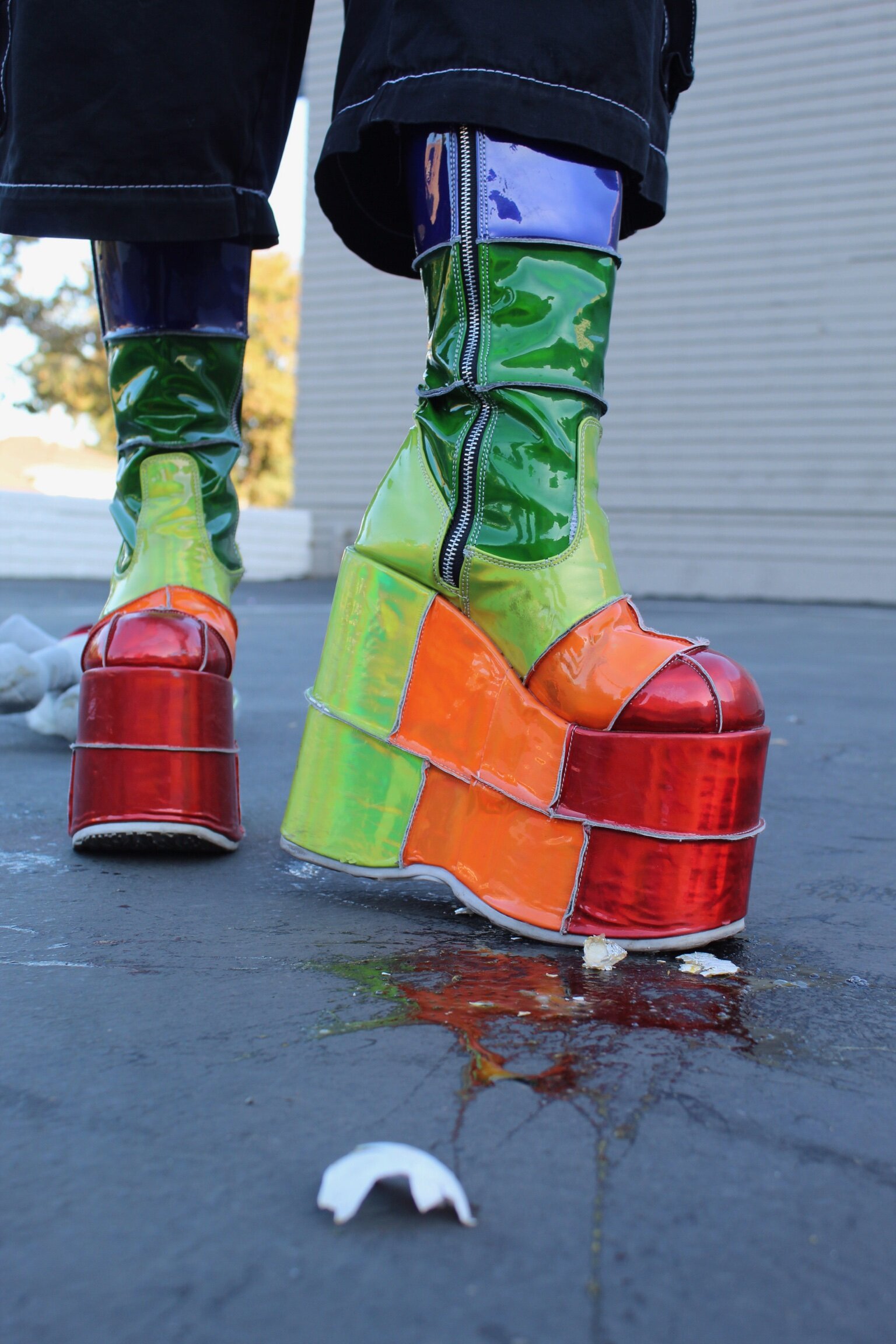

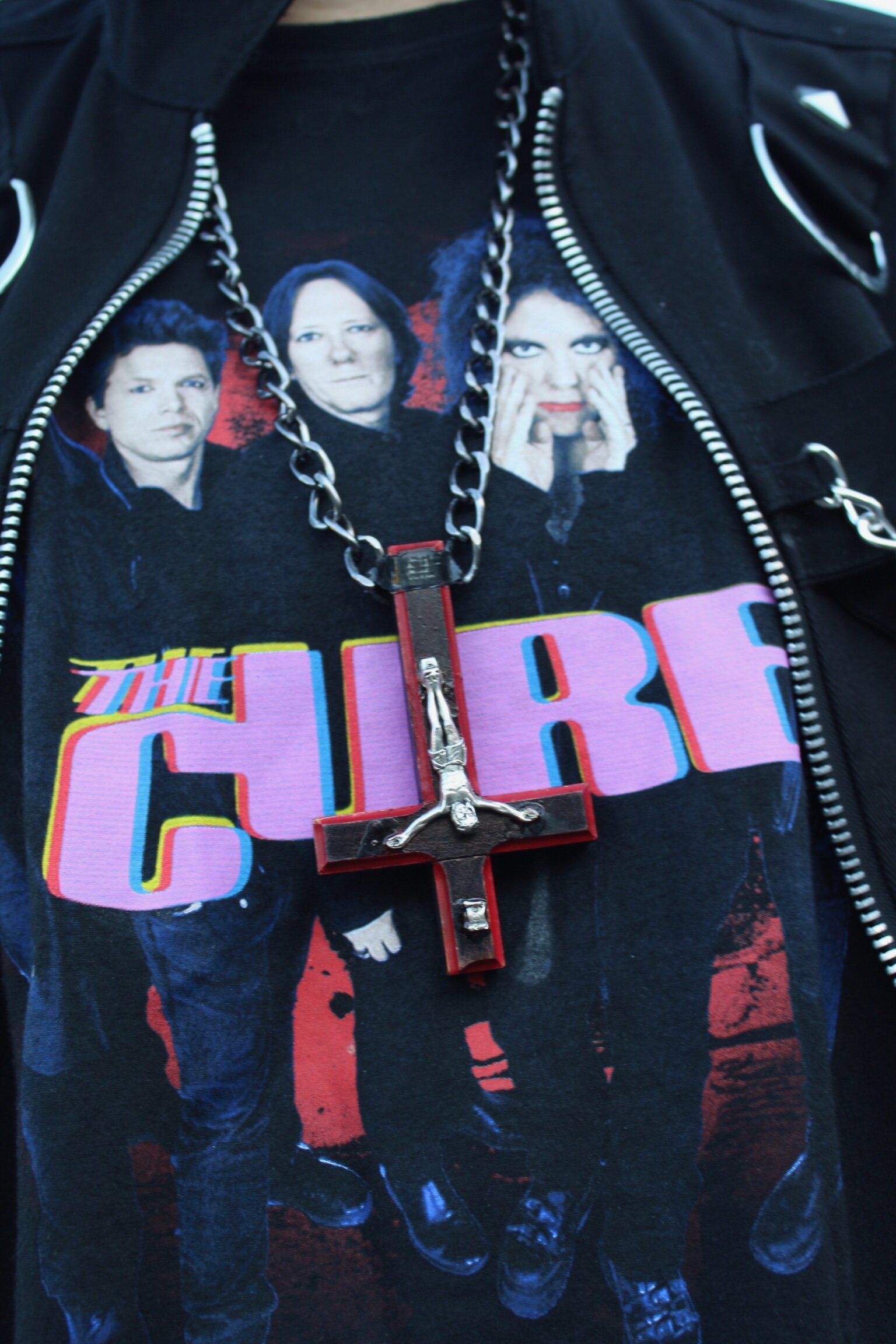
Goth
Known for being the outcast throughout high school history, Goth fashion embraces the “different” and is known for flashing alternative music, clothes, and accessories. Goth originally occurred as a variation of the post-punk genre and much of the subculture is based around the music genre of the same name, so music and band merch is a common feature of the style. Layering material such as leather, denim, latex, and lace are common as well. As far as accessorizing goes, a plethora of buttons, patches, and pins adorning jackets, pants, and bags are a great way to add personal touches to your wardrobe. Jewelry that includes chains, bold shapes and colors, and gothic imagery like cobwebs, coffins, and crosses are must-haves.
Featured students: Lars Milberger (VA ‘21) and Eloise McNamee (VA ‘21)
Mean Girls
As the mother of Y2K fashion, Paris Hilton, once said, “The early 2000s was such a fun and iconic era for fashion.” As far as media is concerned, I think it goes without saying that Means Girls is possibly the most iconic embodiment of Y2K, or early 2000’s, fashion. Much of the fashion trends from the ‘90s lingered well into the early 2000s but with a few changes. Low rise jeans and skirts, chunky belts and necklaces, tank tops layered over t-shirts, and capri pants reigned supreme during this fashion era. The rise of technology had a huge influence in this fashion scene and it was evident in the bright colors, shiny black tones, and the plethora of reflective metallic hues.
Featured students: Dean Knoell (PD ‘20), Ana Soto (PD ‘20), Erin Kim (PM ‘20)
This Was Halloween: Halloween Highlights 2019
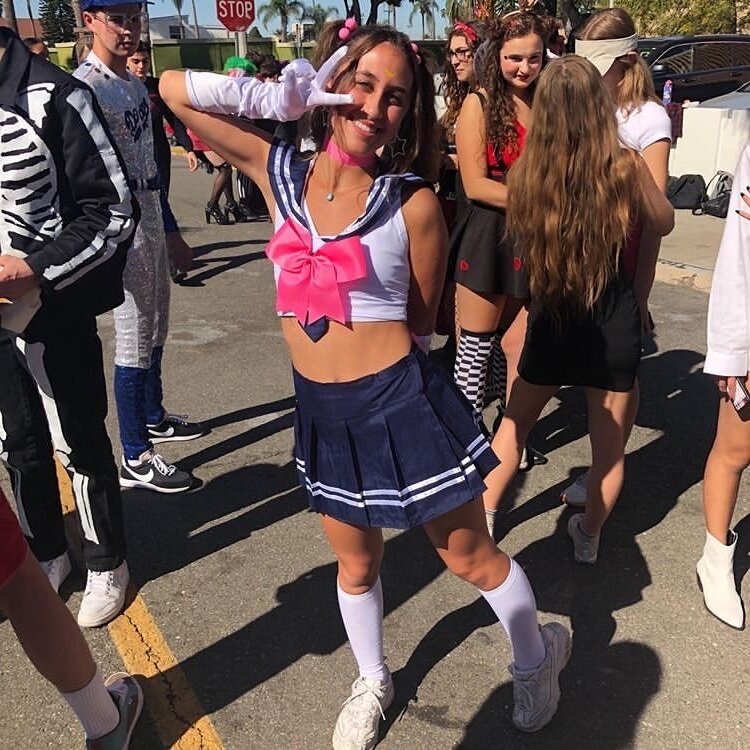
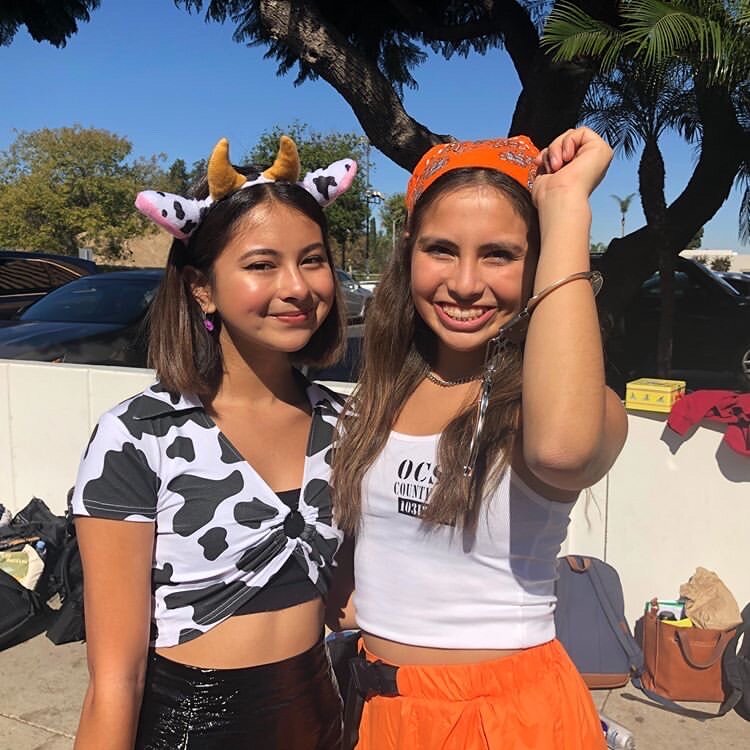
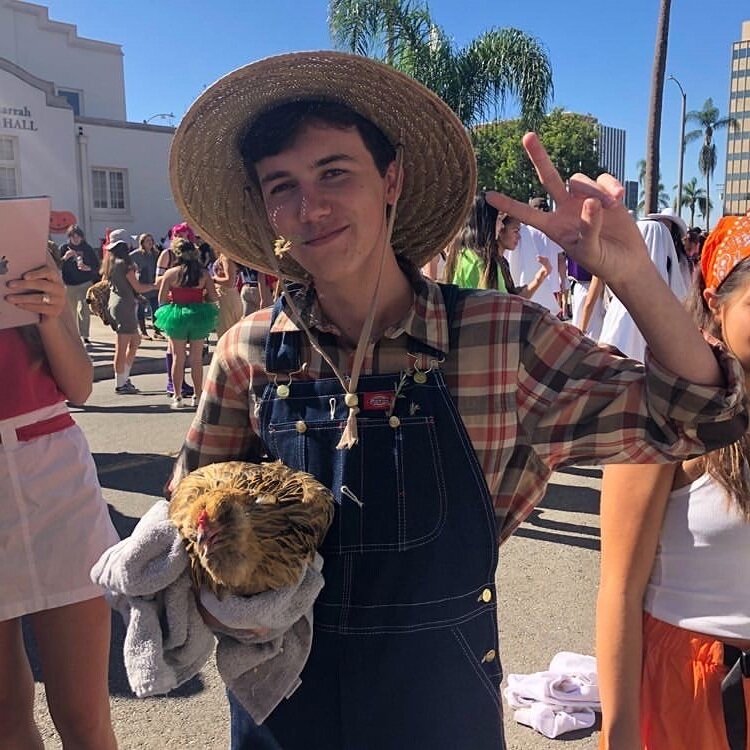
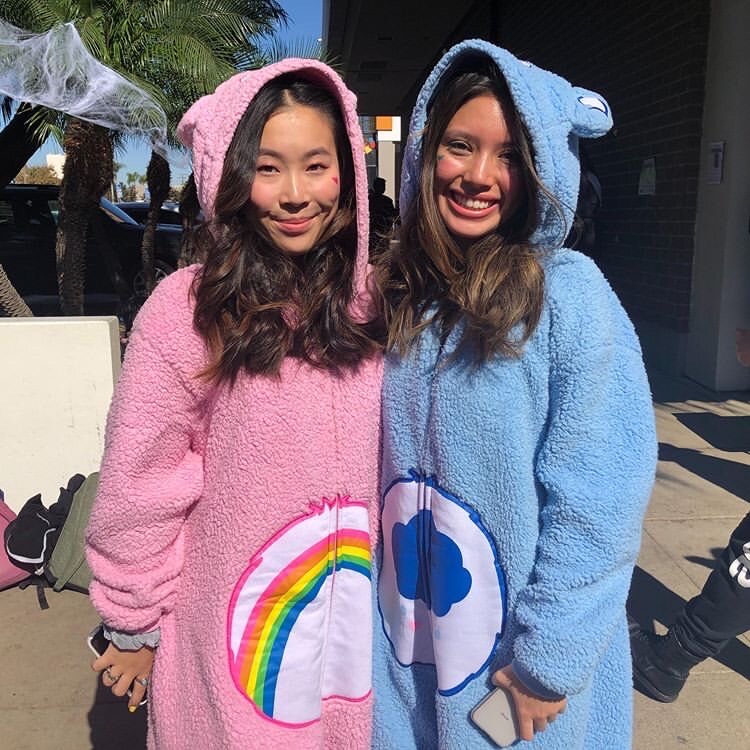
Season of the Roach
Corey LoDuca - Staff Writer
When Corey LoDuca woke up one morning on the Annex floor, she found herself changed into a monstrous vermin. However, Corey’s first thoughts were of getting to class on time, rather than this new situation of roachhood. On the average day, it was necessary to leave 19 minutes before the start of class to arrive on time. Everyone had to account for OCSA’s certified obstacle course, which included: boys throwing frisbees at kids near the Annex and students standing in the doorways to high five each other, blocking traffic completely. Wiggling every one of her new roach legs, she tried to orient herself by finding a clock. What time was it, anyway? And how to maneuver all 17 legs? They were inconvenient at first, but they now provided balance in the Annex’s dark depths. The thick, humid air was surprisingly comfortable for the roach to breathe. Maybe it wasn’t all bad.
The Annex stairs were treacherous for Corey, as she tried to drag her backpack behind her, having wrapped the straps around as many legs as possible. The going was so tough that the weak, overworked roach considered lying down and quitting. She was hoping for the divine intervention of the holy bronze deity, Dr. Ralph Opacic. Thankfully, she found her hope in the counselors’ encouraging words at the Naviance presentation, which now seemed like years ago. Exhausted beyond any bug’s capacity, Corey sought to remember the mindset the presenters encouraged every year. They always said something about growth.
This year, the senior class was stressed beyond belief. A student was crying in the Annex; the pressure of their to-do list was too much. Then they saw a cockroach scurrying by and bitterly laughed. “One must be as hardy as a roach to withstand the harsh environmental conditions at OCSA,” they thought. They began muttering the words “Roach Mindset” to themselves in the face of ordering transcripts, requesting letters of recommendation and taking every AP, SAT and ACT test. Teachers, administrators and parents caught on. Marquis and George’s radios cackled with the message. Funding was put towards replacing Dr. Ralph Opacic’s statue with a bronze casting of a roach. Matthew Morrison gave a press conference at the ceremony to make sure everyone had heard that “Roach Mindset” was OCSA’s new motto. The day of the Naviance presentation, the students snapped, overwhelmed by thoughts of the college admissions process. To console themselves they sang the words “Roach Mindset” over and over. Onlookers clapped, thrilled that the students were thinking about college. Cameras were quickly set up and the Orange County elite were brought in to continue the chant. A crew of TEDx presenters were quickly flown in to make this motivational moment a viral sensation. People with clipboards frantically wrote down plans to rent a venue, get sponsors and print invitations. The Gala theme had been decided. “Roach Mindset! Roach Mindset!”, the chant continued.
Corey stepped of the doors and on to the Annex blacktop. The dry stench coming from the tower was sure to grate any creature’s respiratory system. Feeling sick, the little roach scrambled to turn around and find a bathroom. Students began to arrive, they screeched and pummeled Corey, who was almost to the bathroom. They hated the roach and wouldn’t let it into either of the gendered bathrooms. Hydroflasks and heavy backpacks were slammed into her torso until Corey’s little roach legs stopped moving. A senior ran in and screamed “NO! HAVE A ROACH MINDSET!” But it was too late.
Comic
Vivi Velasco - Staff Writer & Illustrator & Anna Iyer - Staff Illustrator
SATIRE: A Modest Grow-posal
Kyle Keller - Multimedia Co-Editor & Evolution Radio Host
OCSA has a big problem. It’s not the vandalism in the halls, or complaints against the administration or the cleanliness of the bathrooms. It’s gone undiscussed for years, but has been felt for far longer. It’s something overriding and quintessential — something that has to do with this school’s very soul.
I’m talking, of course, about a complete lack of biodiversity.
My name is Patrick Greenbriar, PhD, and I’ve come all the way from London to tell you that your campus is terrible. Even on Google Maps it’s a desert of natural influence: the only visible plants are scraggly, imported varieties, absent of any lust for life, chained to patches of dirt like a dog chained to a stake in the backyard. Now take a look at Dartmoor National Park, my old stomping grounds. Is it reigned in, pruned and approved by a landscape designer? No! You think the inch-tall grass that coats Dartmoor asked permission before it started growing? No! Is OCSA following suit? No! Plants are meant to grow where they please!
Now, I’m not crazy. I know it would be out of the question to advise a complete reconstruction of OCSA that will turn every corner, every classroom into a thriving ecosystem. What I’m advising instead will be smaller, simpler, and only mildly destructive.
I call it “Construction Via Destruction: A Complete Redesign of the Humanities Tower’s Fifth Floor to Expel Human Life and Encourage the Germination of a Full-Scale Native Species Arboretum.” Or simply: the Greenhouse Plan. In it, the fifth floor of the Tower will be cleared of students, teachers, walls, windows and belongings — peacefully in a perfect world, forcefully in a realistic one — to make room for an arboretum of sorts. This location is ideal due to an abundance of sunlight in the area, as well as the disposability of the teachers and staff who work there. Species present would include the Mexican feather grass, the birch tree, jasmine, the white lily, the green tea plant and other native varieties. In time, OCSA would come to be known as a hub for native species in Southern California. Students would be able to obtain paying jobs as ticket sellers, gardeners, or tour guides. It would revolutionize Santa Ana!
I admit that such a task may be daunting, but I should remind you that you’ve got the University of London’s first triple-major graduate on your side. When I arrived in the States, the first thing I did was contact companies who were willing to help me carry out my plan. The trucks can swoop in at any time of the day and within 10 minutes to get the job done. All I need to do is convince your dean of facilities, Michael Ciecek, that the plan is a good one — I’ve emailed him eight times and all I get back is crickets.
Some will call me an ecoterrorist. My only answer to that is that I’m trying my darndest to do it legally.
To bring the Greenhouse Plan to fruition, I need as much support of the student body as possible. That’s why I’m writing to you here and why I chose to be interviewed in the OCSA Monthly podcast. (Kyle has been a great help, but he was quite rude to me.) So won’t you choose change? Won’t you harness every modicum of your rage, discomfort, and lust for greenness? Won’t you help me build a campus we can all be proud of?
That’s what I thought. It’s time for OCSA to get a taste of its wild side.
What If We Voted? Just Kidding... Unless...?
Frankie Fanelli - Executive Editor & Online Co-Editor- In-Chief
Over the summer, seniors Anya Ernst (ACT ‘20) and Arielle Dettmer (CMD ‘20) decided to organize an on-campus voter registration drive. Both girls are very politically active and motivated, as well as part of the Orange County School for the Arts official March for Our Lives chapter, and wanted to spread a message they were passionate about. Specifically, the importance of pre-registering to vote. Dettmer had previously tried to coordinate a similar event in September of last school year, but wasn’t able to bring it to fruition until this year. At a March for Our Lives summit over the summer of 2019, she received more information on how to officially plan the event, reached out to Ernst for help as a co-organizer, and the rest is history. “Our aim was to educate students on legislature and today’s active politicians, as well as the importance of being civically active and engaged,” Ernst told Evolution. During the summer break, the students worked together to gather volunteers and plan the on-campus voter registration event that Ernst described as being “student led but club endorsed.”
Toward the end of September, everyone involved went to 11th and 12th grade social science class and gave a 15 minute presentation on the importance of being civically active. Their presentations boasted slogans and phrases like Our Turn, Our Vote, Our Voice and Voting = Your Voice; Voting = Your Power. They gave instructions on how to pre-register to vote and even gave students an opportunity to do it right there in their social science class using the chromebooks, provided they had their California driver’s license number, the last 4 digits of their social security number, and date of birth and address handy.
Alongside in-class presentations, the young women instituted a challenge where the grade who had the most students pre-register to vote would receive early lunch for a week in order to incentivise the drive. The Class of 2020 won this competition but unfortunately the reward was never instituted (Sorry seniors! It should be coming soon!) In addition, they organized 10th street activities, food, and music to help raise awareness and as a final push to get students to pre-register before the October 20th deadline. The aim of these activities were to “promote OCSA’s youth civics clubs as well as its vibrant social justice culture” and accurately dubbed “Artivism.” These included red, white and blue face paint for the students to show their patriotism, a poster that students could write on and finish the sentence “I want my future to…” and OCSA’s JSA club providing “I believe in…” stickers. In order to draw in voters, Ernst, Dettmer and their volunteers also sold boba and donuts to students and donated all the funds to Ms. Cirigliano’s son, Trent, who is currently fighting a rare kind of Stage IV brain cancer (search #TWrecksCancer on google or social media for more information or to donate).
In the end, the organizers of the voter registration drive put out a google form to collect the outcome of those who pre-registered to vote. Of those who responded, 60.3% were seniors while only 39.7% were juniors. There were a large number of responses and those who pre-registered to vote at OCSA would have likely been a fraction of that number had Dettmer, Ernst and all of their volunteers not put together this voter registration opportunity for the upper-classmen of OCSA.
Interested in registering or pre-registering to vote? Go to https://registertovote.ca.gov/
Special thanks to the students organizers involved:
Isabella Szabo (CV ‘21), Sydney Kaminski (CMD ‘21), Julia Gaspari (CMD ‘21), Valerie Chen (CMD ‘20), Mariah Williams (MT, ‘20), Jai Castro (BRD, ‘20), and Cas Efthymiou (CW ‘20).
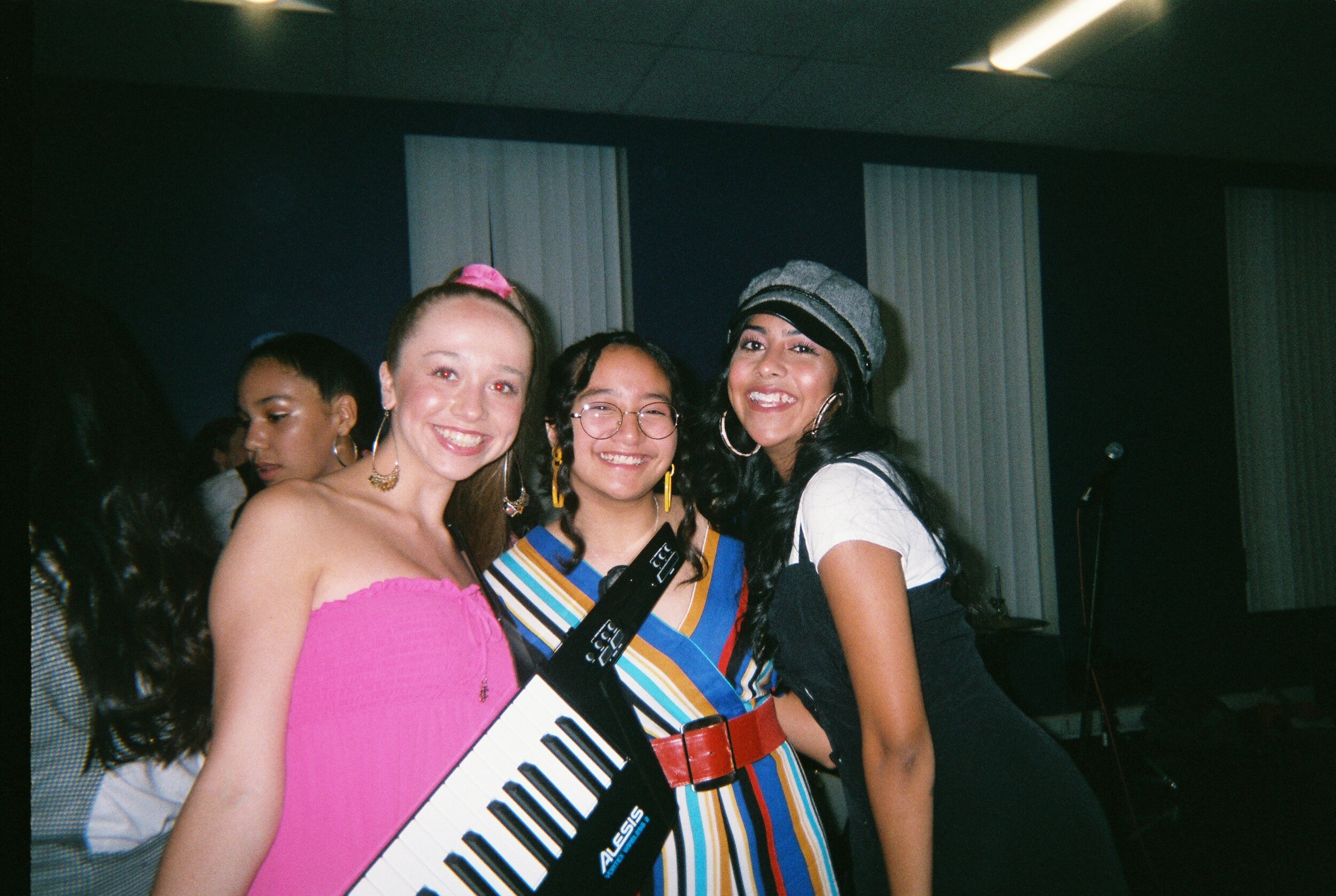
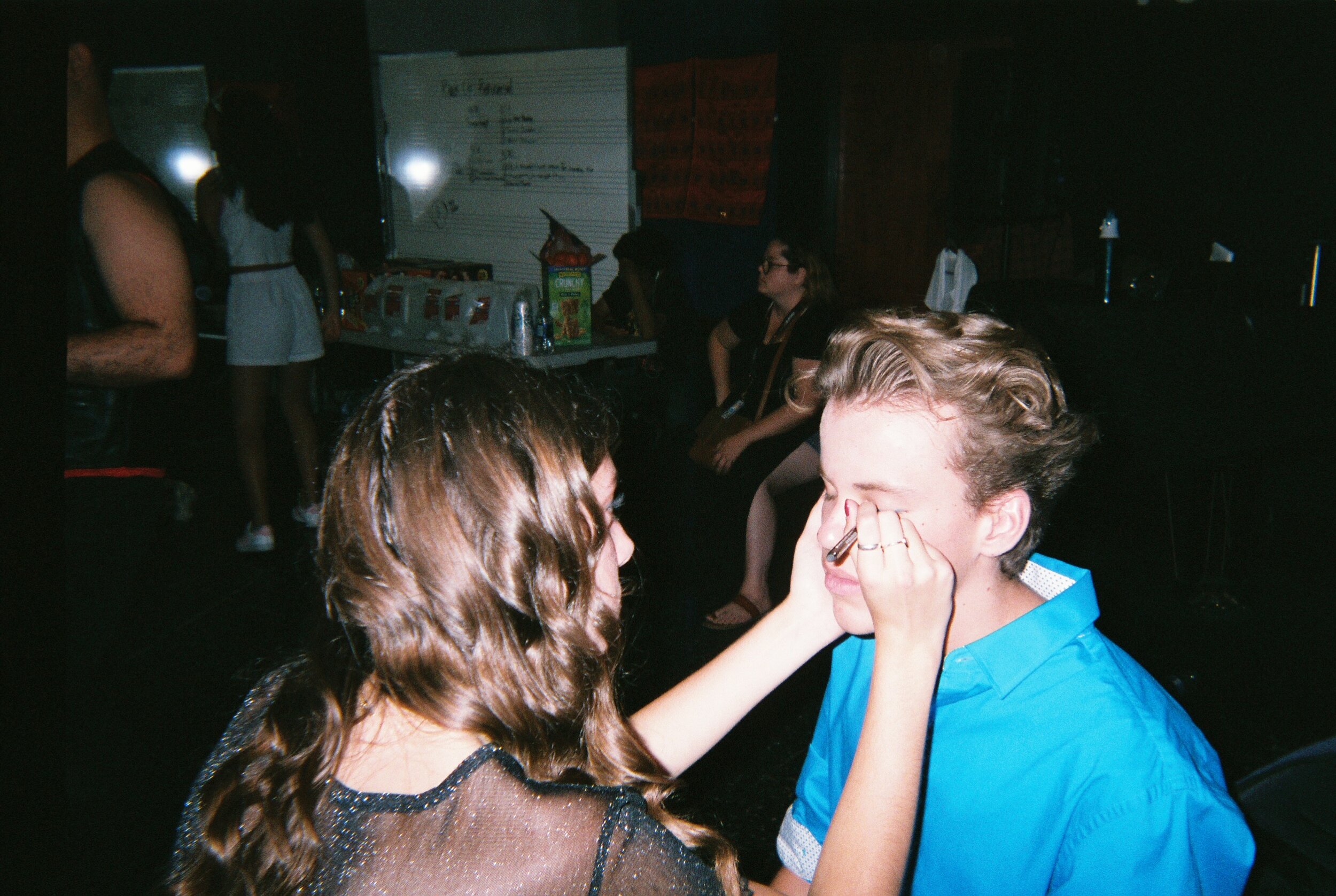

80’s vs. 90’s
Maddy Ernst - Online Co-Editor-in-Chief
Popular Music, formerly known as Commercial Music, radiates a feeling of closeness that is best exemplified in the Class of 2020. The first ever Popular Music show, “80’s vs. 90’s,” began with a safety video, courtesy of the PM senior class. A series of cheesy skits detailed procedures for the show, including reminders to silence our phones and where to locate the bathrooms. The seniors in the video could not stop smiling, and it gave the impression of letting the audience in on one big inside joke.
Sitting down with some of the Popular Music senior class (Alix Page, Elijah Vaughn, James Bergren, Nico Cardoso and Bella Machado) gave Evolution insight into their art, the way they work, and the effect the conservatory has on their lives. The passion they all have was evident when vocalist Cardoso began to talk about the new equipment being used this year. “We’ve recently gotten a new set of equipment, and we transferred our equipment from what we call jam hubs, and now we completely changed our system, so we operate all on in-ears. Now we get to mix and use that equipment as opposed to how we had it before, which was kind of similar, except now we have more technical equipment, and the quality is better overall... or at least it’s getting there,” he finished with a laugh. Everyone commented on their favorite parts of the show, giving insight to what they love about their songs, with Page appreciating Bruce Springsteen’s meaningful lyrics, and Bergren saying, “I just get to yell.”
When asked about new happenings this year, vocalist Page jumped in with her anticipation to work on the senior song, “Freedom ‘90” by George Michael. “For me, it’s just been fun being a senior, you know? And getting to work on the senior number and film the senior intro video! ”As soon as she spoke, the group erupted into laughter and excitement, with lots of “Whoa”s and “Ooh”s. “It’s a really good, happy vibe song,” she finished. “We’re seniors!” said Cardoso, playfully nudging Machado next to him. “Each show, we relate the senior number back to the fact that we’re, you know, graduating! And that we’re gonna move on,” Bergren continued.
As far as the show itself went, the whole audience was blown away by the musicians’ talent. The instrumentalists were phenomenal, with Vaughn’s iconic playing on both drums and bass becoming easily recognizable. Page’s sultry vocals soared on Springsteen’s “Dancing in the Dark,” featuring a dance interlude with Bergren, a sweet reference to the iconic 1984 music video. Machado’s rendition of Cyndi Lauper’s ”Time After Time” had the whole audience swaying, and Cardoso mastered “In the Air Tonight” by Phil Collins. The show was filled with a magnetic energy that was hard to ignore, and the whole crowd was left feeling like they wanted to be up on that stage too. Overall the show was an unbeatable mix of high-energy and vintage madness, making it all too easy to find yourself dancing and singing along with the extreme talent onstage.
Senioritis: November 2019
Anya Ernst - Co-Editor-in-Chief
Whoever said senior year was relaxing and fun was seriously mistaken. No matter where I am or what I am doing all I can think about is COLLEGE. With daily rehearsals and my academic workload (please remind me why I didn’t take easy classes for senior year), it feels like there just aren’t enough hours in the day. As I procrastinate studying or editing applications, there is an overwhelming cloud of anxiety that never seems to move from above my head. Every day, I wake up in a panic, second guessing my decision to prioritize sleep over AP Government homework, and begin forming the mental list of everything I have to do that day. This list normally means staying up until 2 am or missing lunch and Block 7 to get in some homework. I wish I could just skip forward until Thanksgiving break when my applications for Early Decisions are completed and I will have time to breathe. But how am I supposed to enjoy my last fleeting moments of high school when I can’t get in more than five hours of sleep a night?
College applications seem to be all any senior can talk about. There are students who have organized their due dates and audition requirements in perfectly color-coded spreadsheets, but some just don’t even know their Naviance password. No matter their progress or preparation style there is an overarching panic among the senior class.
Trust me, I tried the color coded college spreadsheet, but unfortunately the organized beauty that encompasses your due dates Excel sheet will not make my Common App essay any more interesting, or lessen my anxiety about auditions and prescreens.
But on a more nostalgic note, it seems the Class of 2020 has begun embarking on the long list of “lasts.” Homecoming proved another successful school dance with an overall positive consensus from the student body (though some are still debating the DJ, who I thought was one of the best although the playlist lacked any Beyonce, Lizzo, or Britney). Despite being one of the many seniors who has a “get me out of here” mindset, it hit me about half way through the dance while busting down to “Yeah!” by Usher that this was my last homecoming, ever. And it honestly made me a little sad. But I made a decision to move the thought from my mind and just focus on being moment and having fun. And that is one thing I want to implement throughout the rest of my senior year. Whether it be with college applications, college decisions or as I complete even more “last” moments of high school, I hope to accept the melancholy feelings but focus on enjoying myself and creating memories now instead of getting sad over what will be over later. Because if there is one thing that has been solidified within me from past OCSA grads, it’s that senior year is over before you know it. So I say have fun, prioritize your mental health, and do what makes you happy. Now let’s see if I can take my own advice.
Horoscopes: November 2019
Maddy Ernst - Online Editor-in-Chief
Aries (March 21 – April 19): Aries, your ruling planet of Mars is keeping you busy, busy, busy. As the red planet moves into Scorpio, your powerhouse energy comes into full force, giving you the extra boost you need to finish those projects you’ve left undone. You’re vibing extensively this month, but watch your relationships, and find out what you really want from people.
Taurus (April 20 – May 20): Taurus, lately you’ve felt like your role as peacemaker has been falling to pieces. With the New Moon in Scorpio on the 12th, your relationships have been lighting some fires in you that have been hard to ignore. Try to take a few steps back so you don’t find yourself blowing up; now is a good of a time as any to lean into your introverted side.
Gemini (May 21 – June 20): Mercury is about to move into retrograde, Gemini, so make sure to fix all your communication problems now before they bubble over. However, it may just be easier to make a fresh start with the people in your life, as Jupiter is about to move into Capricorn, bringing responsibility into your professional life and relationships.
Cancer (June 21 – July 22): Cancer, Venus is poised to move into your sign, creating a perfect environment for a new relationship to begin. With the New Moon at the start of this month, the stars are aligning for new connections to form, not just in love, but also in creative ventures. A new partnership is on the horizon for you, so be on the lookout for new people.
Leo (July 23 – August 22): Leo, you’ve been especially and ambitious lately, which is good for all the seniors struggling with college apps. As the New Moon dawns in Scorpio, spend some time with your friends and family. as intrapersonal relationships become increasingly important. Nothing in your life will feel as good if you can’t share it with people you love.
Virgo (August 23 – September 22): With Mars and your ruler Mercury in retrograde, Virgo, it serves you to be cautious in communication. Don’t let that deter you! Once you get past the muddy waters, now is a great time for open heart-to-hearts with people in your life. And if it feels like everything is piling on top of you with no way out, don’t be afraid to reach out to a friend.
Libra (September 23 – October 22): It’s the season of relationships of all sorts, Libra, and this is when you truly shine. As the zodiac’s resident matchmaker, your talents are in full swing as everyone finds their perfect work partner or new best friend. Don’t forget to take some time for yourself, and make sure your expectations for others don’t put people on too high of a pedestal.
Scorpio (October 23 – November 21): Scorpio, as your ruling planet Mars joins the Sun in your sign, your passion is overflowing. You’re full of energy and love for your personal projects, and you’ve finally found that spark you were looking for all through Libra season. But, all good things have a dark side. Be careful not to let that passion send you spiraling into a panicked mess.
Sagittarius (November 22 – December 21): Meditate a litte, Sagittarius, because it’s time for some behind-the-scenes action. Astral bodies in Scorpio are settling into your 12th house of dreams and the subconscious, so you may feel a pull to step out of your usual spotlight and retreat into your mental shadows. It’s important to remember everyone needs me time.
Capricorn (December 22 – January 19): Capricorn, your path right now isn’t exactly clear, which isn’t the best thing as college is on everyone’s mind, regardless of grade. Take a deep breath, have a cup of tea, and leave your Earth sign Type-A persona at the door today. All good things will come in time, and patience is a virtue you’ve yet to master. Don’t worry: you have plenty of time.
Aquarius (January 20 – February 18): Feeling the call of the stars this month, Aquarius? Your otherworldly soul is trying to send you home as Uranus, your ruling planet, finally moves out of retrograde. There’s a pull in your heart, and it’s time to find out what your uniquely you attitude will bring you. It’s a great time for a new artistic or personal venture, so pick up that sketchbook.
Pisces (February 19 – March 20): Pisces, it’s time for your own Perks of Being a Wallflower moment. You’re finally starting to come into your own, thanks to people you surround yourself with, and Uranus coming out of retrograde casts a clear light on your own personal revelations. Enjoy the change! Explore yourself, and don’t be afraid to take your friends along for the ride.




